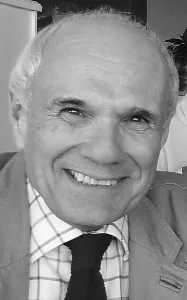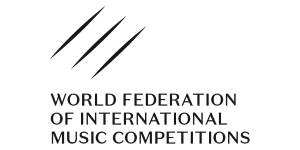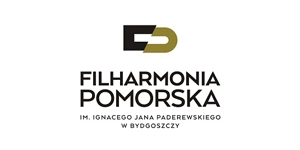Reviews of the 9th Competition 2013
PADEREWSKI COMPETITION
From reviewer’s notepad by Michael Moran

INAUGURAL CONCERT
November 3rd
Rather a wet evening here in Bydgoszcz. Together with the jury I have been given the honour of being accommodated with them in the historic and surprisingly comfortable hotel Pod Orlem (Under the Eagle). I really have no idea what I have done to deserve this care and attention but I certainly appreciate it. The hotel is Art Nouveau in style and nearly all the the period decoration has survived.
Around 5.00 pm I was taken to the Bydgoszcz Filharmonia for two rather special events. First of all the Chairman of the jury, Professor Piotr Paleczny was made an honorary citizen of the city by the Mayor with much pomp and ceremony Uniformed Officers escorted the Standard of the City into the hall and the heynal of Bydgoszcz was played on a cornet. Uplifting ans stirring speeches of various lengths were made (as ever in Poland) celebrating the contribution Professor Paleczny has made to the city and its musical and academic life. He was installed during the proceedings on a scarlet velvet-covered throne and awarded a diploma and then a fine portrait was uncovered.
The splendid opening concert of the competition was given by the National Philharmonic Orchestra under Jacek Kaspszyk. On 1st. September 2013 he took up his duties as artistic director of the Warsaw Philharmonic.
The first work seems singularly appropriate for opening of the competition and the extraordinary contemporary development, one might even say explosion of Polish emigration to England. Polonia by Edward Elgar. The piece was written to be performed at benefit concerts in aid of the Polish Victims Relief Fund. The raising of this money was the major activity of the organistaion known as the Polish Victims Relief Committee. The Committee was founded in picturesque Vevey on the shores of Lac Leman (Lake Geneva) in January 1915 by a group of distinguished Poles.
This brainchild of Paderewski was formed at his curiously eclectic Swiss villa in Riond-Bosson. Hundreds of thousands of Poles suffered greatly during the Great War and were in desperate need of food, clothing and shelter. Paderewski was a generous soul and gave more than $2 million from his own hard earned concert tours to give aid to his fellow countrymen. Themes are drawn from traditional Polish tunes and music by Frederic Chopin and Paderewski. The former include “Śmiało podnieśmy sztandar nasz w górę” (Bravely Let Us Lift up Our Flag) also known as the “1905 Warszawianka” by Józef Pławiński, “Z dymem pożarów” (With the Smoke of Fires) also known as Chorale by Józef Nikorowicz (1827-1890) and “The Dąbrowski Mazurka” which has been the Poles’ national anthem since the regaining of Polish independence. The latter group includes the opening theme from Paderewski’s Polish Fantasy for Piano and Orchestra, op. 19 and a quotation from Chopin’s Nocturne no. 11 in G minor, op. 37 no.1. [Polish Music Reference Centre – Joseph Herter]
This was followed by a fine performance of Paderewski’s Polish Fantasia on Original Themes Op. 19 for piano and orchestra with Eduard Kunz as soloist. Paderewski composed this Fantasia after returning to his home from his second American tour in 1893. It was first performed at the Norwich Festival, in England, on October 4, 1893, where it was highly successful. many regard it as superior to his Piano Concerto. This fine pianist, laureate of many competitions including this one, gave a full ‘Polish’ idiomatic reading and the orchestra responded in kind under the active (almost ‘possessed’ on occasion) baton technique of Jacek Kapszyk.
After the interval the symphonic poem Stanislaw i Anna Oswiecimowie by Mieczyslaw Karlowicz written in 1907 inspired by a poem of Stanisław Bergmann. I had never heard this work previously. The poem describes the legend of the unrequited love of a brother and his sister ending in their mutual death. it is considered one of the masterpieces of the Polish symphonic literature.
The concert concluded with the great Karol Szymanowski orchestral work theConcert Overture in E major Op. 12 sketched in 1904 and finished the following year. Both these works show the strong influence if Richard Strauss. Poles infectious enthusiasm for music and musicians (sometimes overstated) gave the conductor and visiting orchestra a standing ovation.
1st STAGE
November 4th
A ballot late this afternoon decided the order of competitors who will appear tomorrow. Only 34 of the original 48 have appeared in Bydgoszcz.
1st STAGE
1) 10.00 – 10.30 Kośmieja Adam
2) 10.30 – 11.00 Kim Myeong Hyeon
3) 11.00 – 11.30 De Solaun Josu
Break (20 min.)
4) 11.50 – 12.20 Kim Sangyoung
5) 12.20 – 12.50 Lazar Ingmar
Lunch break
6) 16.00 – 16.30 Lekhanov Ilya
7) 16.30 – 17.00 Turpanov Mikhail
8) 17.00 – 17.30 Książek Krzysztof
Break (20 min.)
9) 17.50 – 18.20 Yu Boyang
10) 18.20 – 18.50 Khachikyan Violetta
| And so we begin…. |
Adam Kosmieja – Poland
I enjoyed most his account of the Chopin B-flat minor sonata although such a ‘dramatic’ rendition of the work, particular the first Grave – Doppio movimento often took the risk of inflating the dynamics beyond Chopin’s intentions. The Marche funebre: Lento was quite moving and the meditative central section had a beautiful singing quality. Certainly overall interpretation embraced le climat de Chopin.
Hyeon Myeong Kim – South Korea
In the Haydn sonata he showed admirable articulation and grasp of the work, however I did feel that the idea of musical Vienna of the 18th century and its style eluded this performer. The Presto movement was a ‘race to the finish’ which I feel sure was not Haydn’s intention here. His choice of the Brahms Paganini Variations was ambitious for such a young performer and although he certainly has the work in his fingers, the emotional maturity required to control the tempo of such a great work was absent. Undoubtedly this will come – to perform such a work in pubic is invaluable experience for such a young pianist.
Joso De Solaun – Spain
I felt it unwise to begin with the Liszt transcription of Wagner’s Love death from Tristan and Isolde and so it turned out, for me at least. I felt he failed to build to that, well yes, orgasmic climacteric in the way Liszt planned the work. The more metaphysical elements of this merging of the lovers in death in the mind of Wagner (and according to some authorities Liszt actually conceived the Tristan chord before Wagner) escaped him – the whole was far too physical in essence in his rather disjointed presentation. The two Scarlatti sonatas were well contrasted – one a legato cantilena and the other a more articulated ‘Spanish’ sonata. I only wish pianists would allow music to breathe and give the plant time to grow. I liked the Granados Valses Poeticos very much – performed with energy, grace, power and charm. Enjoyable contrasts of mood.
| My position behind the Jury – identification of the back of heads at request |
Sanyoung Kim – South Korea
One of the finest in the ‘morning group’. Her Bach was beautifully articulated on the piano with excellent tone and touch – not a relentless mechanism as can be the case. perhaps the voices in the fugue could have been more clearly delineated. I loved the Haydn which sparkled away in ‘Papa’s’ healthy way. her avoidance of much pedal was all to the good. The classical Viennese style was well understood and the sound she produced restrained and beautiful. I feel this musician is naturally musical. This is something organic which is difficult to learn. the Andante con moto was very sensitively wrought, the spirited Finale a wonderful contrast of mood. Exciting Haydn I thought – a rare feeling! However it was her musical treatment of the Schultz-Evler Arabesques on a Theme by Strauss By the Beautiful Blue Danube that was tremendously impressive. In the late nineteenth century this was approached as a ‘warhorse’ by pianists but she made a musical piece of the work rather than a vehicle merely to display the pianist’s supreme virtuosity (as in say the mind-boggling Josef Lehvinne on an Ampico piano roll). Not always purely ‘Viennese’ in the waltz rhythm, the whole conception of it was musical and effective.
Ingmar Lazar – France
I felt this pianist had really tremendous digital power and dexterity, yet failed to me move me in his Chopin interpretations of the supreme F minor Ballade which neglected the absolute musical narrative content and the Nocturne in E-flat major Op.55 No.2 where there was little sentiment or the oriental Sarmatian perfumes of the night. The Liszt Spanish Rhapsody was enormously ‘effective’ and powerfully delivered but the huge dynamic he managed to achieve at the conclusion tired me rather than inspiring me.
Ilya Lekhanov – Russia
The Taneev Prelude and Fugue in G-sharp minor op. 29 was in a few words formidable, monumental and absolutely magnificent. His pianistic authority hewn in the demanding mining world of the Tchaikovsky Moscow State Conservatory was clear and imprinted forcibly upon us. I felt the Mozart sonata could have been rather more stylish and a little too ‘romantic’ for my taste (if that means anything). Why do so many pianists so often play repeated phrases exactly the same? Tiresome habit really betraying limited musical imagination. A polished performance nevertheless that could benefit from more Viennese finesse. The Liszt transcription of the Gounod Waltz from Faust was truly orchestral and ‘terrific’ in the literal meaning of that word. I actually do not quite understand why he chose the piece as a competition work. Tremendous technique and power in evidence but the work surely has limited musical significance and is interpretatively undemanding apart from the digital pyrotechnics of course.
Mikhail Turpanov – Russia
The Bosendorfer instrument he chose to play augmented the rich bass of the Medtner Improvisation in B-flat minor to a superb degree (how marvellous the competition organizers have three concert instruments that can be chosen by competitors – Yamaha, Steinway or Bosendorfer). I had not heard this remarkable piece before and found the strength of this playing breathtaking. He then gave an extremely fine and impressionistic performance of two pieces from Debussy’s Images the Reflets dans l’eau (one could literally see and hear the water under his fingers) and the Valse Romantique (luminosity of touch and tone here). The Pabst Concert Paraphrase on Tchaikovsky’s Eugene Onegin. Perhaps transcriptions and paraphrases are the coming fashion among the young pianists of today – we have already heard a few. Somehow despite the extraordinary nature of this performance I felt something lacking, something anachronistic – affectation, panache perhaps – of the great past virtuosi who might have performed this work. I cannot see this type of music as suitable for competitions but then I am not on the jury so who knows how those eminent folk may react.
| Mikhail Turpanov at the Bosendorfer – my favorite concert grand |
Krzysztof Ksiazek – Poland
I liked his Scarlatti sonatas very much – great variety of articulation, fine tempo and repeated passages at least played piano as variety although this too became predictable after a time. The Chopin B minor Scherzo Op. 20 was excellent – light and virtuosic – even if bordering on the ‘mannered’ in expression occasionally. His has a very individual voice and definite views on Chopin as became clear. The lyrical central section was beautifully contrived with fine tone and touch even if the tempo was a trifle slow for me. I am not terribly familiar with the Scriabin Sonata in C-sharp minor Op. 19 so will need to reserve judgement on that. He has a great future ahead as he matures as an artist.
Boyang Yu – China
The choice of free repertoire tells you a great deal about the image a contestant has of himself as a pianist and his idea of the competition. This highly talented young Chinese has a digital dexterity any pianist might envy and his choice of virtuoso piano works indicated his desire to impress us in this way. This he certainly achieved but often at the expense of musicality and understanding of the work in question. His Bach, although brought off with clarity of voice and incisive tone, was rather too relentless for my taste. One must remember that although the ’48’ were instructional pieces they were written for the clavichord, possibly the most expressive keyboard instrument ever devised by man. The profound philosophy and solitary, meditative even introverted nature of these works was absent. The clavichord has a tiny volume and was always a private instrument – one must remember this when transferring Bach Preludes and fugues to the behemoth Steinway. The Chopin Etude in C major op.10 No.1 was breathtaking in presentation but he needs a gentle reminder that the Chopin Etudes are not simply that but contain an inner poetry that must be searched for by the executant. The Liszt Transcendental Etude no.10 although brought off with astonishing power and velocity, seemed to me also to lack emotion – it is not merely a work of raw velocity. The Ravel Jeaux d’eau was satisfying in every respect for me and one could hear and see the fountains as the tone he produced was luminous and impressionistic. The Liszt Mephisto Waltz No.1 again lacked the haunted quality of evil seduction that runs through this Faustian essay in sensual subversion. He needs to immerse himself in Goethe’s Faust and explore Liszt’s fascination with the battle between good and the insidious attractions of evil. I suggest he listen to Daniil Trifonov’s astounding account of this work on YouTube. I hope emotional and musical maturity will come now that he has ‘technique’ and great works under his fingers.
Violetta Khachikyan – Russia
This was a quite wonderful recital on all levels of musicianship. As she played the C major Haydn sonata she selected (Hob XVI : 6) I was curiously reminded of Wanda Landowska and her approach to this classical canon. Aristocratic profile at the instrument. Wonderfully integrated ornamentation augmenting the melodic line as it should, moving and finely controlled lyricism in the Adagio, superb tone and touch at the keyboard. I cannot criticize the Rachmaninoff Etude Tableau in B minor Op. 39 no.4 – an excellent perfromance. However now was to come the great highlight of the competition so far, the Prokofiev Sarcasms Op.3. This extraordinary polytonal essay in the grotesque was brought off with total emotional commitment the like of which I have rarely experienced in the concert hall. Khachikyan utilized a full tonal and rhythmical palette here with desperately moving effect – she became an organic part of the piano. I was brought close to tears by this work which some would not take too seriously.
Prokofiev’s composed Sarcasms between 1912 and 1914. He rejoiced in the controversy provoked by such extravagant compositions and performances, and the subversive ironical element contained within this criticism of the Russian government. In 1941 he reflected on the fifth Sarcasm: ‘Sometimes we laugh maliciously at someone or something, but when we look closer, we see how pathetic and unfortunate is the object of our laughter. Then we become uncomfortable and the laughter rings in our ears, laughing now at us.’ She took us into some unaccustomed realms but it was her superb control of silence that was most powerful. I truly felt here that music was silence punctuated by sound rather than the other way about. A magnificent account by a true artist who communicates her internal emotions intensely. Surely a contender for a major prize here.
November 5th
Kyung Hwa Lee – South Korea
I felt this to be a very polished performer. The Haydn sonata in C major Hob XVI 48 was excellent with fine tone, gracious and ‘conversational’ in the 18th century sense and absolutely full of energy and life. An immaculate performance in a word. In the Debussy Prelude from Book I Les sons et le parfums tournet dans l’air du soir (such a wonderfully exotic title) she expressed a fine sense of impressionism and sensual eloquence. Similarly from Book II the Les fees sont d’exquises danseuses her playing was instinctively musical and of great artistry. This was further enhanced by the Scriabin Fantasie op. 28 where she built a fine edifice from such disparate parts, a coherent whole from this enormously difficult piece. This beautiful work written about 1900 bridges the Third and Fourth sonata. Popular with Russian pianists the Fantasie was forgotten by the composer. An immaculate ‘finished’ artistic player who seldom allows her own personality to cloud the composer’s horizon.
Jung Dasul – South Korea
She chose to play the Beethoven Sonata in E major Op. 109. This sonata was composed in 1820 when Beethoven was completely deaf and suffering ill-health. It is an especially lyrical work. Although clearly a fine rather ‘personal’ performance, I felt some of her interpretative decisions concerning phrasing were given too much licence. The work is a profound personal statement and in the reflective parts of the Adagio of deepest philosophical introspection. I felt this aspect eluded Dasul as the sonata breaks nearly all the rules of traditional sonata form. Beethoven’s approach to the variation form at the conclusion is far freer here than in previous sonatas. She also gave a quite unexpected and fine, dramatic performance of the Chopin F minor Ballade.
Fifi Zhang – USA
By the purest chance (order of playing was by lottery) we were able to hear exactly the same work by another competitor shortly after the first rendition – that of the late Beethoven sonata Op. 109. I found this interpretation completely different, but apart from the excellence of the playing the conception of the entire structure was not entirely coherent which is not surprising given the nature of this rather revolutionary sonata form. I felt that Zhang also failed to penetrate the profundity of the Adagio and the profound sadness and resignation to fate that is contained therein,the attempt to come to terms with mortality. The variations were well conceived but the whole was too straightforward and needed more meditation on the emotional content of this difficult mature work of a composer who was deaf and chronically ill and was to die only seven years later. She then embarked on the fiendishly difficult Scarbo from Ravel’s Gaspard de la nuit. Here her powerful technique was well displayed in this outrageously difficult piece and the grotesqueries of the movement were expressed with abandon.
Roman Martynov – Russia
He began with a musical drama that is so difficult to manage convincingly – the Isoldes Liebestod by Wagner transcribed by Liszt. It was a fine performance but the building of the erotic curve in a smooth sensually rising line to the climacteric, the apotheosis of the metaphysical love/death, is a demanding pianistic task to control and express with authentic passion. The Scriabin Etude in G sharp minor Op.8 No.9 was excellent.
This was followed by the Chopin Polonaise-Fantaisie Op. 61. This work in the ‘late style’ of the composer was written during a period of great suffering and unhappiness. He labored over its composition and what emerged is one of his most complex works both pianistically and emotionally. Martynov succeed in playing many episodes with a haunting beauty of tone and in other sections a rather inflated dynamic that did not sit well and unbalanced the piece. However I feel he has under his fingers the basis for an outstanding interpretation which should mature in time if he gives the work the due amount of thought, analysis of its gestation and is guided in the right direction with it by his teachers.
| Two distinguished jury members – the Austrian Jan Jiracek von Arnim and the Norwegian Einar Steen-Nockleberg – relaxing during a break in the Green Room |
Raul Da Costa – Portugal
I enjoyed this recital immensely. He began with an excellent F sharp minor Prelude and Fugue of Bach that was performed in a manner quite unlike the more relentless and even ‘mechanical’ versions we have occasionally heard previously. It abounded in human warmth and emotion, particularly the fugue. One must remember that the ’48’ of the Well-Tempered Clavier were mainly composed for the highly expressive and sensitive clavichord with a few of the ’48’ perhaps intended for the organ but all predominantly as self-study pieces. Bach undoubtedly played these works himself with emotion – he was an extraordinary passionate man by all accounts.
We then heard the Ballada Op. 16 by Jose Vianna da Motta (1868-1948), a marvelous work by this distinguished Portuguese pianist, teacher and composer and one of the last pupils of Liszt. Composed in 1905 da Motta utilizes two Portuguese folk songs within it – Tricana da Aldeia and Ave Maria. The first part is in the form of a variation while the second serves as a quiet ending to this dramatic and virtuoso piece. The Ballada is considered to be one of his most complete works. I had never heard this work before and was delighted with the opportunity.
Da Costa completed his competition group with a terrific (in the original meaning of that word) and idiomatic rendition of Liszt’s Spanish Rhapsody. This naturally musical and gifted pianist instinctively understood the baroque structure of the work with excellent control of rhythm and glissandi that struck like lightening. The Spanish storm then passed in the night. The understanding of Spanish dance was marvelous and one can only reflect on the impact this work must have had on a contemporary audience at the time Liszt composed it – I could have cheered at the end and done a fandango in the aisle!
Mark Taratushkin – Russia
What a relief from ‘the thunderers’ this pianist gave us with the charming choice of a blithe Schubert sonata, the one in A major D 664. The almost cloudless Allegro moderato was played with beguiling joy and innocence. The Andante could have been a little more heartfelt but then I am an unashamed sentimentalist. The concluding sunny and uncomplicated Allegro is such a lovely and lyrical song. My word it was a relief to hear glorious Schubert after all the virtuosic barnstorming….important though it seems to be in competitions these days
He concluded with a dramatic contrast, a magnificent account of the Brahms Paganini Variations. This was a truly breathtaking performance in terms of tone, sonority, power and contrast of character within the various variations. Really a quite fabulous account of one of the most difficult works in the keyboard literature and one of the finest I have heard for many years. His sense of distances on the keyboard was acutely accurate which meant in the wildest and most terrifying leaps he landed directly on the note or notes which gave them an acuteness and immediacy of attack that was stunning in the realized sound. Shura Cherkassky also practiced distances in silence for the same reason. In massive chords each finger was weighted correctly in the harmonic balance. A true individualist of tremendous talent and surely a contender for a prize here.
Tatiana Dorokhova – Russia
Her Scarlatti sonatas (K492, K87 and K484) were particularly fine, especially the B minor which suits the piano so well. There were a number of early Christophori foretepianos in the collection at the El Escorial in Madrid where Scarlatti lived and composed employed by Queen Maria Barbara of Spain. His sonatas were not all composed for the harpsichord.
In her account of the Liszt Transcendental Etudes (No. 10 and Chasse-neige No 12) I could not help reflecting that what is so difficult in Liszt is achieving a balance between the extreme virtuosity required to perform such works and the musicality contained within them. I felt all too often she sacrificed the musical nature of these works to their fiendish digital demands – quite understandable! She then played the Szymanowski Variations op.3 which is certainly a great work but one I had never heard before and am unable to judge. In fact many of us had never before heard works chosen by competitors in the free repertoire stage.
Nikodem Wojiechowski – Poland
This pianist is the only competitor studying in Bydgoszcz. The Rachmaninoff Etude tableau Op.39 No 5 was well brought off with some panache. The Chopin Bacarolle was simply not a romantic enough outing on the Venetian lagoon for my taste and was a rather conventional account that did not indicate the possession of a keyboard technique that could compete with lets say the Russians in the competition. This became clear once again in the Chopin B flat minor Scherzo which although it was emotionally moving on occasion and well within his grasp, lacked a consistent vision and became uneven in execution as a result. However one must never forget that even to be selected for Stage I of such a competition as this, one has to be an outstanding pianist – we are judging at a particular high level here. Most competitors have already won prizes in previous competitions.
| Nikodem Wojciechowski |
Hwa Sun Kim – South Korea
I found her a most individual and powerful character and superb player of the instrument. The Chopin G minor Ballade was passionate and full of tremendous keyboard gestures of great fluency, rhetoric and authority. However I cannot believe that Chopin was so lodged in the physical world of the keyboard in these great absolute musical narratives as many players would have us feel.
The Dutilleux Sonata Op.1 (1946-1948) was written for pianist Geneviève Joy whom the composer had married in 1946. Henri Dutilleux (1916 – May 2013) was an idiosyncratic French composer much influenced by Bartok and Stravinsky. This performance was absolutely spectacular and for me Kim betrayed an astounding grasp of modern keyboard writing and the unique technique required for ‘modern’ piano works. I watched her imprint her personalty and musical authority on this extremely demanding work in absolute awe from beginning to end. Fabulous sonority and command. The composer died recently so perhaps this was a tribute or at the very least certainly formed a tribute to this remarkable man. She concluded with an equally brilliant Rachmaninoff Etude – the C – minor Op. 39. Surely a major contender for a prize here.
Evan Mitchell – USA
Curious to choose a single rarely heard difficult and romantic work in a competition context as the Brahms Sonata in C major op.1! Brahms wrote three piano sonatas, this early work as a young man in Hamburg in 1853. He had already composed his impressive second piano sonata by this time but chose to publish this piece first because he felt that it was superior. Schumann was impressed by the virtuosic character and loved both early sonatas.
In the opening Allegro I felt Mitchell failed to achieve the Beethovenian grandeur the movement dictates, even demands, which is so reminiscent of the Hammerklavier. The Andante was warm with its Theme and Variations on a courtly love song, the Scherzo excellent in its way but the Finale not a wild enough Allegro con fuoco which should have displayed the pianist’s virtuosity and emotional range but unfortunately did not quite succeed. These competitions are like climbing Everest…
November 6th
| November 6th 2013 is the 153rd anniversary of the birth of Ignacy Paderewski |
Mischa Kozlowski – Poland
I have always liked the Bach/Busoni Chaconne from the violin Partita in D minor BMV 1004. The pianist gave the work a noble opening at just the right tempo, so vital to this work. He did not overplay the work pianistically which was a blessed relief. The polyphony at times was however muddied by over-pedalling but overall a very satisfying performance of a piece that is so often abused by dynamic inflation. The Chopin Fantasy in F minor did not come off so well I’m afraid – slips and inaccuracies crept in perhaps through nerves – not at all surprising in this high level performance environment.
Hsu Yun Chih – Taiwan
This delightful young pianist glided in dressed in a diaphanous salmon pink gown to play first of all the Beethoven Variations in F major Op. 34. It was a refined performance of great sensitivity which embraced the classical style and tonality to perfection. At moments I thought was looking at a piece of oriental Meissen porcelain so beautifully arranged was her posture, dress, piano and hands. The Chopin Barcarole as ever had a rather perfunctory beginning. So few pianists seem to know what a barcarole actually was originally, despite Chopin’s extraordinary development of the genre. It was a charming gondolier’s folk song sung to the swish of oars on the historic Venetian Lagoon or a romantic canal, often concerning the travails of love. To be fair, her Barcarole was not as storm tossed as some.
Editions of the opening octave of Op.60 vary. For me at least it is imperative to get this dynamic and duration correct as it sets the mood and tonal centre for the entire piece. Some editions give a sforzando marking, others simply forte with a staccato duration. At all events the gondola pushes off relatively gently from the pier, there is no violent incident, the boat rocks in the accustomed romantic barcarole rhythm and the love song begins. If one studies the score carefully the dynamic never rises above fortissimo (and then only briefly during the agitated coda. Piemontesi made far too much of this). Most of the piece oscillates gently between forte, piano and pianissimo with subtle degrees of heightened emotionthroughout.
If in addition one considers the restricted dynamic range but extraordinary tonal colour of the Pleyel instruments of Chopin’s day, the grossly inflated dynamics possible on a Steinway or Yamaha behemoth distorts the meaning of this work into a caricature of an intimate love song. Disturbing yet civilized degrees of heightened passion occur during this outing on the lagoon.
It was often observed that Chopin played with a much lower relative dynamic than were are used to today i.e. forte for him was perhaps mezzo-forte for us or even softer. This together with and as a result of the limitations of the instruments of the day means the dynamic scale of the work is not gigantic. Pianissimo on a Pleyel is the barest perceptible whisper.
Berlioz once described Chopin’s own playing
‘….the utmost degree of softness, piano to the extreme, the hammers merely brushing the strings, so much so that one is tempted to go close to the instrument and put one’s ear to it as if to a concert of sylphs or elves.’ (Quoted in Rink, Sampson Chopin Studies 2 p.51).
The Debussy Prelude from Book II Feu d’artifice (Fireworks) was really beautifully and sensitively played and I could readily imagine all the impressionist Catherine wheels, rockets, bursts and falling stars. Such a luminous sound she extracts from the piano. A delightful programme and experience altogether.
Dinara Klinton – Russia
Here we experienced an accomplished and deeply musical pianist, a true artist. The Scarlatti F minor sonata was lyrical and engagingly slow in tempo, clearly one of those he composed in a cantabile style for the Christofori fortepianos he would have encountered at El Escorial. The G major sonata that followed was without pedal and glittering – a perfect contrast in a way. We then moved on to Liszt and the Sonetto del Petrarca 104. Here she balanced the virtuoso Liszt against the musical and philosophical emotional content beautifully – beautifully reflective in essence. The Transcendental Etude No 5 Feux follets was again superbly balanced between these two parameters. Her left hand was particularly remarkable in this regard almost as a separate voice with an independent life of its own. She possesses extraordinary fluency and facility at the keyboard. Then she embarked on the Gounod-Liszt Waltz from the opera Faust. I felt with her rhythm it could have been danced with ease and the whole extraordinary transcription emerged organically. This player is a true artist and must appear among the finalists.
| The piano technician hard at work regulating the Steinway after a powerful use of its resources (Zbigniew Koczorowski) |
Alexey Sychev – Russia
He began with Beethoven’s ‘Waldstein’ sonata in C major Op.53. For some odd reason his appearance and posture at the instrument reminded me of Glen Gould. Rather stylish playing with a true Allegro, the Adagio suitably reflective and the Rondo possessed a charming singing right hand. He has a good command of the classical style but on occasion was far too heavy in touch and tone in the final movement. Beethoven would probably have been overjoyed to have a modern Steinway at his disposal but how this sonata would sound with the excitement of pushing the technical boundaries of the original instrument of Beethoven’s time! The Chopin ‘Winter Wind’ Etude in A minor op. 25 No.11 was brought off convincingly but with a rather heavy touch. To choose the Liszt La Campanella for the competition did not show great imagination but the rendition was as virtuosic with great technical panache as might be expected from a graduate of the Moscow State Tchaikovsky Conservatory.
Nikita Volov – Russia
He began his group with the Prokofiev Sonata in A minor Op. 28. This one movement sonata was premiered in 1917 by the composer. Just reading the list of movements and sub-movements gives the casual reader some idea of the complexity of this work in tempo, mood and emotional scope viz. Allegro tempestoso – Moderato – Allegro tempestoso – Moderato – Più lento – Più animato – Allegro I – Poco più mosso. He performed it with great authority and understanding.
It was surely an unusual choice to approach Handel’s Suite in F-sharp minor HMV 431 as a competition entry on the piano. I was not sure that the sonority of the modern piano and the technical manner in which he played had been suitably modified to represent the baroque style. It did not enhance the suite for me in anyway at all. Of course I am a harpsichordist and although not at all against this sort of thing, to present such material successfully and convincingly one really has to have the genius of Grigory Sokolov in his astounding piano renditions of Rameau, Froberger and Couperin which I have been fortunate to hear in Warsaw. Sokolov in fact illuminates the baroque in unexpected ways and opens up a third dimension to our understanding of the world of such harpsichord works. This manifestly failed to happen here with our dear Handel.
He concluded with the Liszt Mephisto Waltz no 1 conceiving it almost entirely as a virtuoso work. Does this matter I hear you cry? Well if you have heard Daniil Trifonov perform it as I have at Duszniki Zdroj you will say it certainly does matter! This work is full of insidious and misleading emotional ambiguities, cruel seductions and erotic fancy. His approach was breathtaking in its virtuosity but I know more is possible on the extra-musical suggestiveness front.
Zi Xu – China but studying in Bydgoszcz
The audience today was packed with young people which was really heartening I must say, many clearly there to support Zi Xu.
He began with my favorite Chopin Polonaise the F sharp minor Op. 44. He has a marvellous technique, a real grasp of the polonaise idiom and an authentic feeling for le climat de Chopin. However I felt his tone and touch, at least in this piece left a lot to be desired. Actually the repetitive element in the work that makes one feel the crushing Russian heel is brilliantly effective on a Pleyel instrument of Chopin’ s day. The abrasiveness of its insistence was lost on the modern instrument as it became merely a set of repeated phrases. The Mazurkas Op. 59 were indeed finely and sensitively played and perfect in their way – I was reminded of Fou T’song, a master in performing this very tricky Polish dance form – well so Poles tell me ad nauseam!
We again had an opportunity to hear the Liszt Mephisto Waltz and although it was certainly superior musically to that of Nikita Volov it did not reach the Trifonov heights by any means. Is it fair to compare pianists in this way? Probably not but why not when my reservations remain the same.
I quote from my blog entry after the Trifonov recital at Duszniki Zdroj two years ago:
Finally in the Liszt group the Waltz Mephisto No. 1 in A major (Der Tanz in Der Dorfschenke – The Dance in the Village Inn). Trifonov was terrifyingly intense and seemed full of insidious Mephistophelian seductiveness and evil. His unsurpassed technique was numbing and electrifying, like an electrical discharge on the Hungarian Plain. He really did play this like a man possessed, crouching low over the keyboard, leaning back in Mephistophelian derision, grimacing, cackling wickedly…really it was quite something to watch as well as hear and added to the overall dramatic emotional impact. Liszt was obsessed by Faust and he chose the account of the story by Nikolaus Lenau to set this piece of programme music. This passage from Lenau appears in the actual score:
“There is a wedding feast in progress in the village inn, with music, dancing, and drunken carousing. Mephistopheles and Faust wander by, and Mephistopheles persuades Faust to enter and join in the festivities. Mephistopheles grabs the violin from the hands of a sleepy violinist and draws from the instrument seductive and erotically intoxicating strains. The amorous Faust whirls about with a sensual village beauty [the landlord’s daughter] in a wild dance; they waltz in mad abandon out of the room, into the open, away into the woods. The sounds of the violin grow softer and softer, and the nightingale sings his love-soaked song.”
Trifonov through Liszt communicated all this passionate theatre to us in the most intense manner imaginable. ‘What incredible music this is!’ I thought as we leapt up to an instant standing ovation even though it was interval and usually ‘not done’ in modern concert life. the greatest performance I have ever heard or witnessed – and there have been many.
From: http://www.michael-moran.com/2011/08/66th-duszniki-zdroj-international.html
Anna Kavalerova – Russia
Of course one could have to be made of stone not to be blown away by the wonderful golden mane of Venetian blonde hair as Kavalerova came onto the platform. She began with the amazing Chaconne by the Russian composer Sofia Gubaidulina written in 1962. It is a nervous and thrilling work. She may have been indebted to an ancient form when composing this piece, but it is clear that she had mastered it and begun to think of original ways of modifying it. A marvellous interpretation. Kavalerova then began the perfectly sublime Beethoven sonata in E-flat major Op.81 known as Les Adieux. The fact she appears such an intensely romantic figure, so perfectly Pre-Raphaelite, at the instrument only augmented her wonderful playing. She was totally committed and involved with the work at the keyboard. The sorrowful yearning for the absent one in the Andante of separation was full of deep feeling and musicality. Such joy she presented us with in the homecoming Vivacissimamente!
| Anna Kavalerova in the midst of Beethoven’s Les Adieux sonata |
Nino Bakradze – Georgia
It seemed curiously appropriate on Ignacy Paderewski’s birthday that someone performed Beethoven’s Sonata in A flat major Op. 26 with its Marcia funebre sulla morte d’un Eroe.
This was the only movement from his sonatas that Beethoven arranged for orchestra, and was played during Beethoven’s own funeral procession in 1827. Clearly it was a precursor to that in the Eroica Symphony. Chopin himself greatly admired this sonata and even used the same progression of movements in his own Op. 35. Even more appropriate in that case. I felt this pianist had excellent command of the classical style and was possessed of outstanding self-confidence and authority at the keyboard. For some strange reason I was reminded of Gina Bachauer. The Andante con Variazioni showed great variety of mood and tone in each variation with a wide range of articulation and dynamics – staccato, demi-staccato, demi-demi staccato. In the Scherzo too she used a technique of great variety of touch and tone and for me it became a true ‘joke’ with a lightheartedness and humour one rarely hears in performances of Beethoven these days. The Maestoso was exactly that with an excellent noble tempo adopted and true deliberation as the funeral steps fell on the road like lead. The Allegro made a spirited confession of faith and continuance.
Then onto Islamey (An Oriental Fantasy) by Balakirev. It is one of may very favorite virtuoso works in the keyboard literature and I have heard practically every pianist of note play it including many historic recordings when it was popular among past virtuosi such as Josef Lhevinne, Emil Gilels and Vladimir Horowitz. Balakirev wrote of it in a letter to Eduard Reiss in 1892:
‘…the majestic beauty of luxuriant nature there and the beauty of the inhabitants that harmonises with it – all these things together made a deep impression on me… Since I interested myself in the vocal music there, I made the acquaintance of a Circassian prince, who frequently came to me and played folk tunes on his instrument, that was something like a violin. One of them, called Islamey, a dance-tune, pleased me extraordinarily and with a view to the work I had in mind on Tamara I began to arrange it for the piano. The second theme was communicated to me in Moscow by an Armenian actor, who came from the Crimea and is, as he assured me, well known among the Crimean Tatars.’
This performance was without doubt one of the greatest I have ever heard and I truly mean that. Bakradze had entire command over this technically formidable work with no technical limitations to halt the wild tumultuous Tartar ride she had in store for us. It was a truly fabulous account. I was blown away emotionally and shouted many ‘Bravos’ and gave it a standing ovation (alone). I asked myself do audiences have any idea what they are hearing? Were they deaf to the magnificent accomplishment here? I spoke to her briefly afterwards and she is such a modest person and simply said it was her favorite piece and that she had played it and thought about it for many years – and she had brought the rather wild and uncompromising spirit of Georgia to our hall! Absolutely memorable in every way.
| Nino Bakradze and the ‘Hero’ Ignacy Paderewski during Beethoven’s op. 26 |
Sheeyoung Moon – S. Korea
Seldom does one encounter in life the overwhelming impact of perfect beauty, but here we did both physically and in performance at the piano. As she opened the Haydn Andante & Variations in F minor Hob. XVII:6 one was immediately struck by the refinement of sound and sensitivity of this playing, such fine fingers. Her touch and tone are absolutely superb. Perfect understanding of the classical period and how to transpose it from the 18th century instruments of Graf, Walter or Stein to the modern behemoth Steinway or Yamaha. The Schumann Toccata in C major Op.7 was among the finest and most perceptive performances I have ever heard. She clearly saw so much within this work rhythmically and harmonically (often played as a superficial showpiece) invisible to rest of us. A revelatory interpretation indeed. The first movement of the Scriabin Sonata in G sharp minor Op. 19 under her fingers was to die for with its romantic impressionism. Scriabin wrote of its programme:
‘The first section represents the quiet of a southern night on the seashore; the development is the dark agitation of the deep, deep sea. The E major middle section shows caressing moonlight coming up after the first darkness of night. The second movement represents the vast expanse of ocean in stormy agitation.’
At moments it seemed utterly clear she must win this competition but…who knows the will of a jury and the compromises any committee decision entails in life! I am so looking forward to hearing her play the rest of her Stage II works and Semi-Final pieces – there is no doubt in my mind we shall hear them!
Alexandra Jablczynska – Poland
How difficult it must be for a competitor to follow on immediately after a preceding performance of such quality. She began with Albeniz and two pieces from the Iberia Book I – Evocation and El puerto. Here was a beautiful evocation of sunny Spain much needed in Poland at this time of year! Idiomatic and rhythmically excellent. She brought tremendous energy to the Prokofiev Sonata in D minor op. 14 and I found the Scherzo particularly enjoyable. The Andante was sensitive and reflective. She responded and captured the mercurial percussive even tragic nature of this Prokofiev sonata very well. Prokofiev dedicated this sonata to his friend and fellow student at the St. Petersburg Conservatorium, Maximilian Schmidthof, who committed suicide in 1913.
| A rather nice happy portrait in the Green Room during the small celebration of Padrerewski’s birthday during the first break with champagne and Black Forest gateau.From the Lt. Stanislaw Zielinski, Henryk Martenka Director of the Competition and Professor Piotr Paleczny Chairman of the Competition Jury |
November 7th
Daiki Kato – Japan
I was very much looking forward to the only Japanese competitor and he did not disappoint me. The Beethoven Sonata in E-flat major Op. 27 No.1 began very quietly with the Andante to the point where I began to doubt his abilities. I need not have worried as his interpretation developed over time like a wonderful organism. The Allegro molto vivace exploded onto the keyboard and the Adagio con espressione was played with heartfelt, sensitive expression. The Allegro vivace possessed terrific rhythm and simply flew along unhindered by any neurosis on the part of composer or executant. Kato utilized some wonderful and varied changes of mood.
Liszt loved the music of Schubert and Kato had chosen his setting of the lyrical song Fluhlingsglaube S. 558 (Faith in Spring). A gentle and tasteful choice for a piano competition surely – truly admirable and sensitively played with luminous tone.
He then launched into the tour de force of the Liszt transcription of the Saint-Saens tone poem for orchestra known as the Dance Macabre (an accurate transfer from one medium to another – orchestra to piano – as opposed to a freer paraphrase). No matter one’s station in life, the Dance of Death unites all. Danses Macabres were written to remind us of the fragility of our lives and how vain are the glories of this earthly life. Death was not sanitized and was a far closer neighbour in the days of Franz Liszt.
| This image is the Dance of Death in the German printed edition, folio CCLXI recto from Hartman Schedel’s Chronicle of the World (Nuremberg, 1493) thought to be created by Michael Wolgemut (1434-1519). |
One can easily understand why Liszt was attracted to such a macabre subject, fascinated as he and many other Romantic composers were by the incontrovertible fact of death and transience. He wrote many works concerning that same gaze into the abyss (the Totentanz for example). Kato gave us a tumultuous performance altogether that was excitable, ominous and virtuosic at once.
Danylo Saienko – Ukraine
After having listened to many highly refined players with an exquisite command of the instrument it was quite a surprise to hear a pianist who was not shy of being slightly ‘rough around the edges’. This does not mean to say he was anything but a brilliant player, it is just that, well, his approach was decidedly masculine. He began with the Mednter Tales Op. 20 (F minor, E minor, B minor). His 38 Skazki (generally known as “Fairy Tales” in English but more correctly translated as “Tales”) for piano solo contain some of his most original music and are as central to his output as the piano sonatas. They are associated with Russian folk art and were composed at different times in his life and of a different scale. I had not heard these Op. 20 ones before and thought he seemed to have an instinctive understanding of them. Here I felt Saienko was a natural musician that did not want to allow an over-considered intellectual approach to music to obscure his own instinctive, physical reaction to it.
The Haydn Sonata in F major Hob. XVI: 23 was robust rather than refined and the Adagio in particular not over-sweetened. Of course there is a case to be made for a more robust ‘Papa Haydn’ fond of cigars and coffee in Vienna coffee houses. The Liszt Chasse-neige was brought off with what one might call ‘rough conviction’ rather than the perfectionist approach one might expect of the ladies from Asia. This unexpectedly physical and overtly masculine approach suited this music very well I thought. The approach however did not suit the Chopin Etude no. 11 in A minor from the Op. 25 set where slips and bumps are not really acceptable in any interpretative scheme.
Ilya Maximov – Russia
I found this a most impressive recital with complete emotional engagement with the music and commitment to the instrument. The Bach Prelude and Fugue in C major was adequate but not outstanding – for me it lacked some warmth and was rather too distant. The Rachmaninoff Etudes-tableux No 3 in C minor, No. 6 in E-flat minor and No 9 in C-sharp minor were impressive and convincing interpretations. Max Harrison the Rachmaninoff biographer refers to the Etudes-Tableaux as ‘studies in composition….[that] investigate the transformation of rather specific climates of feeling via piano textures and sonorities. They are thus less predictable than the preludes and compositionally mark an advance.’ I loved his Debussy Etude No. 11 Pour les Arpeges composes which had wonderful wash of impressionistic sound, great contrasts and fine articulation. Debussy himself described his own Etudes as ‘a warning to pianists not to take up the musical profession unless they have remarkable hands’. Maximov has them. He concluded with an excellent virtuoso account of the Liszt-Paganini Etude in E-flat major No.2.
Veniamin Zhukov – Russia
He began unconventionally with the very interesting late Liszt work Nuages gris (Grey Clouds). In this piece the composer is charting experimental unknown compositional territory for his time and clearly looking far into the future in his imagination – an avant garde work in the true meaning of that phrase. Liszt was suffering from failing health and injuries in an accident at the time (August 1881) which may go some way to explaining the dark mood of the work. It prefigures the development of impressionistic colour in European music as in say Debussy. Perhaps it is more important that Zhukov chose to play this in competition than how he played. It is a short and simple work with profound implications. He then embarked upon the Mephisto Waltz No 1 and all my observations above apply here as he approached it predominantly as a virtuoso showpiece.
Zhukov’s adventurous and unconventional attitude to his programming reached fulfilment in the Karol Szymanowski Metopes Op. 29. Anna Iwanicka-Nijakowska explains:
Szymanowski composed the work in the spring and summer of 1915. The inspiration came from the famed reliefs (Metopes) from the Sicilian temple of Selinunte, which he saw at the National Museum in Palermo four years earlier.
United by their theme, the Odyssey, the cycle’s three pieces refer to Odysseus’ three different adventures. The first one, The Sirens’ Island, dedicated to Szymanowski’s cousin Lola Rościszewska, is a musical vision of women with fish tails, their fatal singing bringing death upon seamen. The second piece, Calypso, dedicated to Szymanowski’s sister Anna Szymanowska, invokes the story of the eponymous nymph from the island of Ogygia who kept Odysseus prisoner for seven years, while the third one, Nausikaa, dedicated to Marianna Davidoff from Kamionka, an estate neighbouring on Tymoszówka, eulogizes Odysseus’ unhappy, unrequited love for the daughter of the king of the Phaiakians.
Rather than literally illustrating the Greek myths shown on the Sicilian reliefs, Szymanowski’s music conveys their fantastic air and the composer’s sensation. It is a new style music with a new sound, new harmony and a new type of texture. The three music pictures, while static in character, are vibrant and shimmer with colours. This is achieved by the employing closed techniques and architectural principles, including the atonal harmony, multiple, dissonant chords (The Sirens’ Island), uniquely beautiful, lyrical melody with numerous figurations and passage works (Calypso), ostinatos and cadences (Nausikaa) and, last but not least, the form with features of a free poem rather than a traditional structure.
I have only heard this piece once live in London and really do not know it well enough to comment in detail on this interpretation however I found it absolutely remarkable and dazzling at times. However it would take me time to develop a strong affection for it I think.
| Announcement of the Stage I results From the Lt. the Chairman of the Jury Professor Piotr Paleczny, Jury member Hiroko Nakamura and Director of the Competition Henryk Martenka |
| The Stage I results and Harmonogram for Stage II adjusted by the beautiful Paula |
2nd STAGE
November 8th
Hyeon Myeong Kim – S. Korea
This was a very fine recital indeed. The Beethoven Sonata in D minor Op.31 No 2 showed an excellent command of the classical style with light pedalling and the clearest articulation. One must remember that Beethoven was rather a brusque man and I felt the approach slightly mannered on occasion. The Adagio was deeply felt and the considered tempo expressed this sense of reflection. The final Allegretto was also at a fine tempo, absolutely note perfect and more to the point, achieving a beautiful bloom to the tone colour. This pianist has a refined touch at the instrument.
The Paderewski group included the Cracovienne fantastique Op. 14 which presented us with an excellent Polish folk dance rhythm and Paderewski’s augmentation of this into the world of fancy. The Krakowiak is a syncopated, fast Polish dance from the Krakow region said to imitate horses. He followed this with the beautiful melody of the Legende Op. 16 No.1. Of course this music and the ‘story’ it tells speaks of take place in a time far more civilized and cultured than our own.
The Rachmaninoff Sonata in B-flat minor op.36 was rhapsodic and deeply satisfying. I remember queuing for 8 hours for one of the last concerts Horowitz gave in London when he played this very sonata and it has remained a favourite of mine ever since. This performance was part of a brilliantly executed programme of great refinement and style.
Josu De Solaun Spain
I was looking forward to this recital as I remembered with great pleasure his Granados from Stage I. He opened with a rather robust Haydn Sonata in C minor Hob. XVI 20. He followed this with the large group of demanding Brahms pieces, the 6 Klavierstücke Op.118
- Intermezzo. Allegro non assai, ma molto appassionato (A minor)
- Intermezzo. Andante teneramente (A major)
- Ballade. Allegro energico (G minor)
- Intermezzo. Allegretto un poco agitato (F minor)
- Romance. Andante—Allegretto grazioso (F major)
- Intermezzo. Andante, largo e mesto (E♭minor)
It is clear De Solaun loves this composer and he played with a broad tonal palette in what might be tempted to call a ‘manly’ style absolutely suited to the late Brahms of 1893. Brahms dedicated the work to his unrequited love Clara Schumann and the set is rather more introspective than much of his other solo piano music. There was much affecting beauty particularly in the Romance and great variety of approach to each piece.
De Solaun is very fond of Scarlatti which comes as no surprise being Spanish and so he chose Paderewski piece entitled Caprice (genre Scarlatti) and performed it in a rather scintillating manner. The Nocturne however was not sentimentally sweet enough for me which came from his adoption of a rather surprisingly indelicate tone and touch in this work.
Sangtoung Kim – S. Korea
This was a truly wonderful recital which must make her a contender for a prize. She opened with a work I was unfamiliar with but told later that it was popularized by Horowitz. This was the Carl Czerny Variations on a Theme by Rode ‘La Ricordanza’ Op.33. Jacques Pierre Joseph Rode (1774 – 1830) was a French violinist and composer. Her superb articulation, tone, touch and style made this a real delight to hear. This was followed by the Beethoven Eroica Variations Op.35. She began with a marvellous ‘orchestral’ chord which simply exploded from the piano – magnificent – all the notes within the chord weighted perfectly. I remember hearing Emil Gilels playing this work at the London Festival Hall many years ago and was similarly astounded. Kim a supremely natural musical pianist. Her wonderful rhythms are so full of life! Each variation was so characterful and full of contrast and drama. Minimal use of the pedal allowed an unblemished classical style to emerge. The Fugal variation had the tremendous unstoppable momentum fit for the progress of a ‘hero’.
The Paderewski chosen was the charming Album de Mai : Chant d’amour Op. 10 No.2 which was wrought with rare beauty of tone and sentiment. The Caprice Waltz Op. 10 No. 5 was stylishly brought off and simply excellent in all respects. This lead naturally into her clear love (maybe obsession with) Vienna and the Strauss waltzes (I remember the fabulous Schultz-Evler arrangement of the Beautiful Blue Danube she played in Stage I). Here she chose the charming, sparkling joyful, uncomplicated and tuneful Alfred Grunfeld Soiree de Vienne Op. 56. It was quite wonderful to watch this young South Korean girl bring off music from the ‘old civilised world’ with complete success, dare I say possibly superior to many an Austrian pianist. Such taste, culture and refinement was in her approach to this work, no cliches, crudeness or cheap thrills.
Mikhail Turpanov – Russia
The great Bosendorfer was wheeled onto the stage for this programme. He opened with the Scarlatti Sonata in G minor K. 450 performed in excellent detache style and then as a contrast in the cantabile G major sonata K.470. A lovely pair of sonatas. The rich lower registers of the Bosendorfer vibrate in the abdomen and are inimitable on other instruments.
He then played a spirited Paderewski Un moment Musical Op. 16 no.6, from the Polish Dances the Mazurka in B major Op.9 No.4, a scintillating Caprice (genre Scarlatti) Op. 14 no. 3 and to conclude from the lovely Album de Mai: Scherzino Op.10 No 3. All were well performed but overall I felt he was not really sufficiently period charmant and cultured. How could he be so in 2013 when the social milieu Paderewski inhabited has disappeared forever and this fragile music has almost been forgotten as an expression of its sensitive sentiments and sensibility.
The Prokofiev Rondo op. 52/2 and the Etude op. 52/3 were pleasant enough but I cannot really understand why he included them in a competition programme. He then embarked on the great Schubert Wanderer Fantasy. I felt he unfortunately had limited understanding of this work. Much of his playing could be described in the words of C.P.E Bach in his Versuch über die wahre Art das Klavier zu spielen 1753 (Essay on the True Art of Playing Keyboard Instruments)
‘They overwhelm our hearing without satisfying it and stun the mind without moving it.’
The dynamic scarcely fell below forte or fortissimo and the ‘interpretation’, such as it was, displayed extraordinarily limited understanding of Schubert’s intentions in this piece – the operatic nature of ‘The Wanderer’ passing thorough varied landscapes and the joyful and bitter experiences of life on his great journey through it. He wrote it in 1822 only six years before his premature death. The work is surely a keyboard version of what might have been another great Schubert song cycle. The main theme in a hardly festive C-sharp minor is actually taken from his song Der Wanderer. Terribly disappointing as Turpanov is a fine musician with a towering technique to match. More background research on such great works before performance please!
I once heard the great pianist Alexander Melnikov at the Chopin i jego Europa Festival in Warsaw give a brilliant account of this work on a Conrad Graf piano which illuminated the shifting landscape and fluctuating moods in an unprecedented manner perfectly suited to Schubert. Conrad Graf (1782-1851) was an Austrian-German piano maker whose instruments were used by Beethoven, Chopin, Schubert and Clara Schumann among others. They were capable of extraordinary sonority and effects.
| Ignacy Paderewski late in life at the piano in the wonderful film starring him entitled Moonlight Sonata (1936) |
Krzysztof Książek – Poland
It is such a pleasure to see this young Pole doing so well in competition. In this stage he did not disappoint and seems to be at some sort of peak just now. He began with the Mozart 8 Variations in A major on Come un’agnello from Sarti’s Fra i due litiganti, K460. This was a performance that showed the definite ‘operatic’ origins with a particularly lovely tone, sense of classical style and detache articulation that suited Mozart’s keyboard writing perfectly.
This was followed by far the best Paderewski we have heard in the competition and it was so fine I am almost sure it will not be bettered (there is a special prize for the finest Paderewski performance). From Miscellanea he played the Theme varie in A major Op. 16 No 3 which is such an attractive piece and gave us a truly rumbustious Cracovienne Fantastique which really set us tapping our feet and resisting the urge to leap up and dance.
The early Brahms work Variations in D major Op.21 No.1, a beautiful, introverted piece (the original theme has the tempo marked as Poco larghetto) was not quite as successful without the what one might call ‘dark tonal weight’ required for this composer. The slow coda of the eleventh and final variation leading to the ecstatic closing is one of the most beautiful pages in all of Brahms. A recital where Ksaizek rose magnificently to the occasion. Bravo!
Violetta Khachikyan – Russia
A fine recital as we have come to expect from this artistic and highly gifted player. She opened with the Paderewski Nocturne which to be honest I felt could have been played with far more sentiment – it allows one tremendous scope in this regard and I have not yet heard it at the ‘right’ slow ‘dwelling’ sentimental tempo as yet. The Caprice (genre Scarlatti) was absolutely super. The rendition was exciting and very ‘Scarlattiesque’, sparkling and virtuosic. The best interpretation of this piece yet. So involved was she that she bowed to the clapping audience entirely forgetting it was not a concert but a competition. This may be the way she approaches competition performance – just another concert really!
The Bach-Liszt Prelude and Fugue in A minor BMV 543 was fine in its way and again when watching her profile and posture playing Bach (even with the appearance of Liszt in the score) I was reminded again of Wanda Landowska. Khachikyan has the most extraordinary long, fluid arms that move like wonderful reeds in a gentle musical breeze. Hardly any pedal – a wonderful performance for me of a work I adore.
She concluded with Schumann’s Carnaval. From the noble tempo adopted at the excellent beginning a characterful, absolutely individualistic performance of the work unfolded with the most glorious piano tone imaginable. There were ‘off ‘moments naturally but at this level of musicianship there is so little than can be said in mere words in constructive criticism .
Kyung Hwa Lee – S. Korea
Here we have a real enigma that gave me much pause for thought. A pianist who plays with the utmost refinement, glorious tone, fabulous fingers and articulation, note perfect and yet much of what she approaches is lacking in expressive power. I also felt this with her execution at Stage I. It is as if this quest for immaculate execution has clouded and stifled the passion of her soul. The Beethoven Sonata in A flat major Op. 110 is a case in point. I did not find the first movement at all Molto espressivo, the Scherzo also not particularly meaningful, the Adagio left me unmoved and yet it is one of Beethoven’s most anguished utterances and the Fugue rather passionless in its driven existential anger. Was the tone simply ‘too beautiful for Beethoven, a man who cared little for the state of his pianos (food left inside, full chamber pots underneath, legs sawn off) sacrificing all physical comfort and luxury to his cosmic spiritual conceptions. I would prefer to pass over the Cesar Franck Prelude, chorale and fugue in silence. There was something bloodless about this interpretation that contained scarcely any of the extreme intensity of emotion in works by this composer. Am I losing my grip or is Lee a true enigma?
Roman Martynov – Russia
It was as if Paderewski himself had walked onto the stage with his fantastic mop of hair and vestigial mustache. An odd competition choice the Bach/Rachmaninoff 3 Pieces from the Partita in E major for solo violin. I thought these rarely performed works were not performed with sufficient humour and sense of fun. I do not believe they should be considered as deeply serious meditations on Bach.
I did not feel he played the beautiful Paderewski yearning contained within Melody op. 16 No.2 with much poetry or charm – something his music requires on occasion. Not sufficient fin de siecle elegance and refined cosmopolitanism. The famous Menuet op.14 was rather contrived in its ‘stylish’ execution – the grace did not emerge naturally from within the piece but was rather an applique cosmetic enhancement. Martynov did not appear at home, or even like this sort of music and the competition requires two pieces of Paderewski to be played as a mandatory requirement.
Possibly confirmation of this was in the brilliant performance of his major work at this stage of the competion, the Samuel Barber Sonata in E-flat minor op. 26 (1949). It was first performed by Vladimir Horowitz and one can quite see why as it is fiendishly difficult to bring off. In this performance two movements were particularly astonishing for me in different ways – the second movement Allegro vivace e leggero and of course the turbulent and quite fantastical Fuga which has often been performed alone it is so spectacularly difficult. awesome and impressive to hear. This work was the only work that impressed me in this recital and how impressive it was! But is this enough for an entire competition stage?
November 9th
Raul Da Costa – Portugal
Bach is clearly a favorite composer with this pianist (also in Stage I) as he began with Bach’s Fantasia and Fugue in A minor BMV 904. In some ways this is an ‘old fashioned’ manner with the discreet use of the pedal, but to my mind this merely enhances the emotional side of the composer and I found this interpretation deeply satisfying because of that (and remember I am a harpsichordist. Remember Rosalyn Turek on the piano? And then one remembers Landowska…). However I felt the Fugue was somewhat lackluster and could have been presented as a ‘grander’ conception. He then played one of the Paderewski pieces, the Nocturne, and in its heartfelt slow tempo, slightly separated hands to bring out the melody more clearly (actually in the Paderewski manner), it was a beautiful and moving rendition. Certainly the most beautiful we have heard so far in the competition.
The Schumann Toccata in C major Op. 7 was excellent from this musicalpianist who has great talent. The idea of the work moved from terrific energy, towards complete abandon and them final calm resignation. Rather a more physical approach perhaps than than the extraordinary view of this work given us by Sheeyoung Moon earlier in the competition. Paderewski then appeared once again in the Menuet. Usually the piece seduces by its charm and melodiousness perhaps through excessive sentiment but Da Costa had clearly put a lot of thought into his interpretation which abounded in lovely tone, touch and in particular affecting phrasing and he actually made something of the piece (unlike some in this competition who were clearly merely fulfilling ‘regulations of the competition’ in including his works in superficial approaches). In an interview I had with Da Costa in the internet studio he said he felt there was always a serious element behind the apparently rather superficial nature of some of Paderewski’s solo piano music.
He completed his group with the Brahms Variations on a Theme of Handel. His approach was full of fire and energy, beautifully under-pedalled with excellent phrasing and not overblown. Perhaps this attractive economy was because to me he did not seem to observe the repeats in the work for some reason, although I have not looked at the score in detail for some time. The dynamic was kept within the limits dictated by ‘Brahms looking at Handel’ which was a balm to the ears. There was great variety in each variation with total emotional commitment to the work – he clearly loves baroque music and understands earlier instruments. We also discussed that in the studio and the influence in this regard of his great mentor Arturo Pizzaro. The structure built to a powerfully convincing conclusion of great nobility. For me Raul is a true artist with a great future and not merely a pianist.
Mark Taratushkin – Russia
I was not taken with this recital unfortunately despite my very positive Stage I comments. The Debussy Suite for piano composed in 1901 premiered by the great Spanish pianist and specialist in ‘new music’, Ricardo Vines. The Prélude was dedicated to Debussy’s student Mlle Worms de Romilly, who notes that the movement ‘tellingly evokes the gongs and music of Java’. This was simply presented as a virtuoso exercise with scarcely any impressionist sound field. the Sarabande was rather lacking in expressive possibilities and the Toccata seemed to me to be in completely the wrong sonority for Debussy. In fact much of this recital was in exactly the same inflated sound world which was particularly limiting and very reductive. The Paderewsky Legend Op. 16 No.2 was out of all proportion to the character of the piece with inflated dynamics. TheCaprice (genre Scarlatti) presented as a super-virtuoso work in brilliant style bu unsuited to the smaller-scale nature of these works. I felt he did not understand the Paderewski period at all, the charm and grace of society among civilized folk.
The Brahms Sonata No. 1 in C major (see above for more information) in the Allegro lacked the Brahmsian grandeur vital to the opening of all his sonatas – it lacked nobility. His rather crude sound in forte/fortissimodynamic is unremitting and tiresome and does nothing to assist our understanding of the music or what he has to say about it. That being said the Andante was suitably reflective but again the Scherzo was certainlycon fuoco but the phrasing restricted any dynamic variation. In the Finale. Allegro con fuoco a far broader phrase of Brahmsian ampleness and scope would have been appropriate. If one begins an increasing fortepassage at too great a dynamic one has nowhere to go except through the sound ceiling of the instrument intro the world of sheer noise and I am afraid this occurred. we were certainly ‘down in the quarry’ by the conclusion of this work. So disappointing as clearly Taratushkin has enormous undeveloped talent. What a change from Stage I where was so positive about his playing!
Hwa Sun Kim – S. Korea
She began her recital with the Bach Prelude and Fugue in B-flat minor BMV 867. The sonority – touch, tone and degree of detache playing – was perfect for Bach but I felt the Fugue lacked internal energy. The Debussy was taken from Images Book I. The Reflets dans l’eau had a beautiful impressionistic sonority, limpid character to the sound and touch and glorious phrasing. Quite superb and one felt w one was gazing at a glittering lake in summer. The Mouvement showed wonderful control over the sound texture and phrasing of the complex rhythms She uses the pedal with virtuosity to create a wealth of sound colour. One is reminded of Chopin’s remark that ‘The pedal is a study for life.’
The Rachmaninoff B-flat minor sonata had a fine, tremendously dramatic opening as I am sure the composer intended. The tempo was excellent with wide dynamic range, a haunting quality and dark shadows. With her fine articulation she never broke the sound ceiling of the instrument even in the most forte passages. A superb song emerged from the fabric as the sonata became more rhapsodic, if that is not too obscure and vague a remark. A truly excellent performance and furthermore excellent Rachmaninoff.
In the Paderewski Album de Mai: Au Soir Op.10 No.1 she was so refined, elegant and terribly Chopinesque in performance. If I were to criticize her at all I think she could have done with a little more ‘period’ Central European feel. The Scherzino op. 10 No.3 danced along beautifully.
Hsu Yun Chih – Taiwan
The Paderewski Melody Op. 16 No.2 was truly lovely lacked a Central European fin de siecle feel which is entirely impossible to ask of such a young pianist. The Cracovienne fantastique Op.14 No.6 danced along in fine style. There was accuracy and correct sonority in the Bach Toccata in C- minor BMV 911 but for me there was not much excitement in the rather moderate tempo she adopted and I like my toccatas to be exciting! The Mendelssohn Fantasia in F-sharp minor Op. 28 had moments of extraordinary pianissimo playing with marvelous dexterity but somehow I felt she did not come to grips with the emotional content of this work. The work originally had the title Scottish Sonata and contains all the marks of the composer’s later ‘Scottish’ works, including chords with open harmonies, blurred pedalling and strongly dissonant crescendos. It is generally considered one of the finest of Mendelssohn’s virtuoso piano works. Evidence of this heritage was slightly lacking.
She then took up the Out of Doors suite by Bella Bartok. The work is made up of five pieces:
- With Drums and Pipes – Pesante
- Barcarolla – Andante
- Musettes – Moderato
- The Night’s Music – Lento – (un poco) pìu Andante
- The Chase – Presto
I cannot possibly discuss her approach to each piece and the details of each structure. Save to say that she entirely understands the use of the piano as a percussion instrument rather than a melodic one in this work. The opening was absolutely brilliant with fantastic percussive effects of drums. The sound world she created was of astonishing abstraction with almost painful clarity and ‘Swiss watch’ accuracy of duration. The ominous, threatening nature of The Night’s Music was captured with almost frightening power – the cicadas, birds, frogs and peasant pipes of an Hungarian summer. The composer wrote in a letter that he would allow the pianist to play the world of night insects ad libitum but to be honest I am unsure whether she did this as I was not reading the score. Her control over pianissimo is astonishing. She has an absolutely precocious sense of duration and keyboard geography. Undoubtedly she will move into the semi-final round.
The remarkable Meissen porcelain figure of Hsu Yun Chih from Taiwan – a beautiful moment indeed
Dinara Klinton – Russia
She began with the Paderewski Melody Op.16 No.2 which was particularly beautiful and the Caprice Waltz Op.10 No.5 which no other competitor had attempted. She went to the trouble of making fine pieces out of both with her superb tone, touch and phrasing. The Beethoven Sonata in F-sharp major Op. 78 had remarkable ‘conversational’ phrasing particularly in the second movement which made enlightening sense to the listener. Hard to fault. She then played all the Op.25 set of Chopin Etudes which for me at least was a revelation. She revealed all manner of inner complexities invisible to me previously as well as the familiar approaches one tends to absorb as the benchmark. And then comes along a supremely musical individual like this…It was one of those outstanding performances of a much loved work where one has absolutely nothing to say after it is complete – a completely integrated, brilliant and consistent vision of these taxing Etudes.
Dinara Klinton in deep concentration before the beginning of the Chopin Op.25 Etudes
Alexey Sychev – Russia
The great Haydn E-flat major sonata Hob. XVI : 52 (1794), part of his threeEnglish Sonatas, was dedicated to the pianist Theresa Jansen-Bartolozzi, whom he met during his second visit to London. The work is clearly written for fortepiano and shows some influence of C.P.E Bach. The performance was fine in general but I did find the final Finale-Presto rather uptempo for my taste but I expect with such a technique in my fingers I would be tempted into such a race to the finish! We missed many of the witticisms and elegance in this concluding movement. This large scale work is certainly one of my favorites and he handled the French Overture opening rather well.
In the Paderewski Album de Mai: Scherzino and the Nocturne, like many of the pianists, they seem not to have sufficiently explored the period riches contained in these fine works. This may well be doing Sychev a disservice but one felt he was merely fulfilling competition regulations although they were naturally competently played at this level if perfunctorily.
The Liszt B minor Sonata was a very good performance of this tremendously demanding work. I felt however it lacked refinement and some of the episodic contrasts were too extreme as Sychev became carried away by his keyboard passions. A fine performance marred by rather ugly sound as the piano ceiling was breached in fortissimopassages.
The manner in which a pianist opens this masterpiece tells you everything about the conception that will evolve. The haunted repeated notes Sychev produced were of just the right duration (a terrible battle lies in wait for pianists here – Krystian Zimerman drove his recording engineers mad repeating it hundreds of times before being satisfied). His duration and dynamic boded well for the outcome but problems evolved.
Just to have this vast work in your fingers is a massive achievement but what you do with this is another matter altogether, what you have to sayabout this work. This is a profound piece, too often played as some type of hectic fantasy or dream fantasy when it is actually in many respects a philosophical dialogue between different fundamental aspects of the human spirit as symbolized by Faust, Mephistopheles and Gretchen. Liszt was tremendously influenced by literature and poetry in his compositions and in particular Goethe’s Faust, the dramatic spiritual battle between Faust and Mephistopheles with Gretchen hovering about as a seductive, lyrical feminine interlude. And it is a far more complex musical and structural argument than that any many performances would indicate. Pianists who aspire to this work should listen to the Alfred Brendel or Claudio Arrau account of it. There was a world of difference in the disciplined sound spectrum to that of Dinara Klinton.
Xu Li – China
As ever here (pace Raul Da Costa) the Nocturne was performed with too little period sentiment (listen to Paderewski’s own recording) but theBurlesque Op. 14 No.4 (an interesting and unique choice) was infectiously energetic. The Szymanowski Mazurkas Op. 50 (1924-26) he played came off rather well. The composer was well aware of the challenge of extending the form given to us by Chopin and extending it, breathing new life into the form.
‘The originality of Szymanowski’s mazurkas lies primarily in combining the mazurka dance rhythms, belonging to the folk music of Mazowsze and Kujawy, with the musical folklore of Podhale. Underlying this peculiar synthesis was a desire to renew the traditional form of the mazurka which, after Chopin, found many imitators, but no creative continuation either in Polish or European music. According to Adolf Chybiński: “Szymanowski regarded this form as ossifying in stereotype and destined for dying out in artistic music. He once said (in Lvov) that an ‘interbreeding of races’ might regenerate it.” [Adam Mickiewicz Institute and Polska Music] The Beethoven ‘Les Adieux’ Sonata in E-flat major op. 81 was very well performed but I was seldom moved emotionally in terms of yearning in theAndante (L’Absence) or joy in the Vivacissimamente (Le Retour) as I was by the Stage I performance by Anna Kavalerova.
Now to the Liszt. Xu Li began with that immense work the Vallée d’Obermann from the Années de Pélérinage Première année. Suisse. I adore this work, Liszt inspired by literature once again – the novelObermann by Étienne Pivert de Senancour.
‘The vast consciousness of Nature, everywhere overwhelming and everywhere unfathomable, universal love, indifference, ripe wisdom, sensuous ease – all that the mortal heart can contain of desire and profound sorrow, I felt them all.’
(Obermann from Letter 4)
I have been in love with the work since my teens. Xu Li gave a fine not entirely mystical impression of grand Swiss landscape one could imagine in one’s mind’s eye. Horowitz was fond of this work and his interpretation at his 1966 Carnegie Hall recitals is always the greatest to my mind. Liszt himself wept on hearing it again later in his life – the memories it evoked for him were so strong.
Lake Geneva and the Alps from Glion above Montreux taken on my recent research trip to Switzerland. The Chateau of Chillon so beloved of Lord Byron, that great influence on Liszt, is in the bottom left-hand corner
Anna Kavalerova – Russia
I felt it terribly ambitious for a young pianist and not entirely wise in competition to select the late Schubert Sonata in C-minor D. 958. The depth of emotional expression within it I felt was completely beyond her, despite having the work well within her technical grasp. The sonata is tied to the other two in the trilogy of late mature works (D. 958-960) and is profoundly associated with his song cycles such as the melancholicWinterreise where the shadow of death looms menacingly, even terrifyingly, over the utterance and the story. Examining the tumultuous emotions contained within this sonata, it is fairly well accepted that it is somewhat autobiographical and shot through with dark anticipations of oblivion only relieved by a few fluffy clouds of sweet nostalgia. I would prefer not to comment in detail on the performance but wait and hope her teachers guide her along an illuminating philosophical route in interpreting this great masterpiece.
The Paderewski Nocturne and Caprice (genre Scarlatti) I did not feel had been acquired to a high technical and interpretative level and was disappointed as I had really enjoyed her Stage I performance. Only in the Chopin Mazurkas Op. 33 (1838) did I feel a return of the limpid tone and poetry of the Stage I Kavalerova. To see her seated at the instrument with that wonderful glowing mane I was immediately put in mind of a family summer evening in a Polish Dwor somewhere in Mazovia, dusk approaching, the daughter at the piano playing rather softly and a few friends clustered about listening to this intimate performance. After so much powerful music that had come before in this competition, the immortal stature of Fryderyk Chopin as a supreme melodist struck me forcibly, washed over me like a balm of the most exquisite charm and refinement.
Nino Bakradze – Georgia
As you will have read I was waxing lyrical over Stage I showing and keenly anticipated her playing of the great Brahms Sonata in F-minor Op. 5(1853). A wonderful choice for her particular abilities and spirit. The Paderewski Melody Op. 16 and Menuet did not move me greatly although charming and played in an elegant style.
The magnificent, noble opening she gave the Brahms in the Allegro maestoso was ‘majestic’ indeed which evolved with what I can only term overwhelming grandeur. The fortissimo chords that cover such a wide range of the keyboard she presented with the greatest control and discipline. She understood the essentially Romantic spirit of the work fused into a classical edifice, the architecture of which is truly awesome to behold over the approximately 40 minutes duration (in the original meaning of that word). The Andante espressivo – Andante molto was steeped in ardent nostalgia with beautiful tone and eloquent phrasing. There was great variety of tone and touch and I really felt she had mastered a distinctly Brahmsian tonal palette. She adopted a magnificent tempo in the Scherzo, so musical and dramatic, never breaking the sound ceiling of the piano. Brahms gave the Intermezzo the title ‘Rückblick‘ which literally means ‘Remembrance.’ I fancied I heard a Brahms chorale embedded in there somewhere. Bakradze wound into the virtuosic and triumphant close with the greatest majesty. I feel she has true nobility in her playing, with an amplitude of expression given to few pianists, full control over silence, musical meaning to the foreground of her thoughts as she modestly bows to a composer’s essential intentions. As I mentioned earlier she reminded me of the great Greek pianist Gina Bachauer with her big, penetrating tone and command of the Romantic in music.
And yet I now know she did not proceed to the Semi-Final Stage. Absolutely inexplicable….
November 10th
Zheeyoung Moon – S. Korea
This remarkable pianist began her contribution with Brahms Klavierstucke op. 119 and a more ardent and gentle beginning with the finest culture and taste one could scarcely imagine. The Intermezzo in B minor was beautifully unsettled, full of the reflective anguish of past unrequited love, moments of anger and resistance followed by final resignation. Moments of Arcadian bliss followed happy memories of calm refection cultivated in the consoling refuge of age.
I can only describe the mood of the Intermezzo in C major under her fingers with the opening stanza of Shelley’s poem To a Skylark
Hail to thee blithe spirit!
Bird thou never wert-
That from heaven or near it
Pourest thy full heart
In profuse strains of unpremeditated art.
Wonderful tone, articulation and phasing here. The Rhapsody in E-flat major was full of variety and love of the piece. Glorious tone, her phrasing a revelation. This was fantastic and powerful playing of Brahms.
The Paderewski Melody op. 16 possessed wonderful rubato (important considering Paderwski commented that the entire nation of Poland moved in tempo rubato which I entirely agree with to my occasional extreme discomfort!). In the Cracovienne she penetrated to the core of the music and beyond. Marvelous variety of what one might call ‘peasant sonority’ during the dance, variety of articulation, phrasing and ‘attack’.
However it was in the Liszt Venezia e Napoli from the Années de pèlerinage: ‘Deuxième année: Italie’ (1859) that she really shone. In the initial Gondoliera based on the song ‘La biondina in gondoletta’ by Giovanni Battista Peruchini, one could literally hear and feel the waters of Venice under the gondola one was seated in – a most extraordinary and delightful, even uncanny evocation of water. She is able to extract extraordinary beauty of tone from the Steinway. Then the lovely Canzonewhich is based on the gondolier’s song ‘Nessun maggior dolore’ fromOtello by Rossini. Sun and shadows as the music became quite transparent under her fingers.
Her dynamic range suits this hall and begins and dwells at a relatively lower dynamic than many pianists in the competition. Never noisy, always a rounded and full sound. At the other end of the spectrum her ultrapianissimo is quite stunning. She literally becomes the music she is playing with extraordinarily revealing phrasing. The Tarantella was absolutely superb and was presented not merely as a virtuoso vehicle (although it certainly was that). Liszt uses themes by the French musicologist Guillaume-Louis Cottrau (1797–1847). All manner of keyboard wizardry were in evidence but always subordinated to the poetry and the literature that so inspired Liszt. Amazing in a word. ‘Decorative’fiorituras always subordinated to the melody – so difficult to achieve in Liszt. What an artist we have here! A winner ? It hardly seems a relevant observation considering the treasure of the music we heard!
Zheeyoung Moon in the midst of Venezia e Napoli from the Années de pèlerinage: ‘Deuxième année: Italie’
Daiki Kato – Japan
How does one follow that within two minutes? But he did with an excellent and highly imaginative Beethoven Sonata in G major Op. 31 No.1. With his excellent control of the under-pedalled ‘classical’ style and tonality theAllegro vivace was full of good will, entertainment and humour. Beethoven was striking out on a new compositional path from strict Viennese classicism in this sonata. The Adagio was also highly amusing as played by Kato, full of the bucolic parody of Italian opera which was so popular in Beethoven’s day. The ‘twiddles’ were almost too much of a joke and I almost laughed aloud! The Rondo. Allegretto fresh and youthful, surely one of the best rondos the composer wrote. Kato really understood this sonata and it was a delight from the beginning to the sudden rumbustious conclusion.
Liszt set a number of Chopin songs and this one No.5 was originally entitled ‘My Darling’ and to my mind one of the most beautiful. Kato played it divinely with aching tenderness and love. Absolutely exceptional – one of the most beautiful renditions I have heard. As might be expected after this understanding of Chopin, the Paderewski Melody p. 16 No.2 was a thoughtful and beautiful interpretation although the Scherzino that followed could have been somewhat more lively.
The Bartok Out of Doors suite was I thought even more realistic and authentic than that of Hsu Yun Chih (see above). I shall not repeat myself concerning the work. His face was a picture as he ‘saw’ the birds and insects flitting about! A brilliantly talented young player with a great future ahead.
Daiki Kato in a sunny, witty mood in the Beethoven Sonata op. 31 No.1
Danylo Saienko – Ukraine
The pianist looks like an intellectual student of Liszt that has stepped out of a sepia photograph in Weimar. I have little to add to my comments on him from Stage I (see above). The Paderewski (Au Soir Op.10 No.1 and the Nocturne op. 16 No.4) were both rather too straightforward and conventional in approach for my taste. The Scherzino was over-pedalled with no suitable articulation to give it life.
In the Schumann Kreisleriana he played with very broad strokes like a man from the vast plains who wishes to play the piano well but is not overly concerned with academic details. There is a place for such pianists but possibly not in competitions. He seemed to have little knowledge of the E.T.A. Hoffman tale of Kater Murr (The Tomcat) that inspired Schumann. He seemed to be doing very little with this wonderful music as episodes followed instantly from one another without suitable transitions. What was he trying to say about this piece?
The Shostakovitch Prelude and Fugue in D-flat major Op. 87 No.15 was not familiar to me so I could not possibly comment on the interpretation. Sounded great to me….but was it?
Ilya Maximov – Russia
An excellent pianist who like his name is not shy of giving us the maximum. He was the only pianist to select a matched pair of Scarlatti sonatas (D-minor K.32 and D-major K.33) as advised by the great editor of Scarlatti and harpsichordist, Ralph Kirkpatrick. How well the cantabile sonata matched the lively detached version. Both excellent and idiomatic performances. Great phrasing at the conclusion of K.33.
The Paderewski Nocturne as he played it suddenly put me in mind of a love affair in Central Park New York filmed by say Arthur Hiller of ‘Love Story’. Nothing wrong with that! His Caprice (genre Scarlatti) was not surprisingly quite marvellous with his love of Scarlatti sonatas in evidence again. Probably the best interpretation during the competition of this piece. I very much enjoyed his beautiful and heartfelt performance of the emotional Cesar Franck Prelude, Fugue and Variation in B-minor Op. 18.
I was much looking forward to the Rachmaninoff Sonata in B-minor Op. 84. The opening was rich and full-blooded but overall there was far too much dynamic overplaying which ruined many of the rather beautiful things he was able to produce throughout. His mezzo-forte and pianobrought the sonata to passionate life but beyond…’methinks he doth protest too much.’ Too much dynamic inflation worried my concentration to the point where I was not listening fully anymore. Such a pity as I am sure if he had scaled the whole thing down dynamically, the structure of the work would not have been perceived as out of proportion. However a brilliant and powerful conclusion of tremendous conviction and energy. Just a pity we were not in Carnegie Hall instead of the Bydgoszcz Music Academy!
SEMI-FINAL
November 12th
Josu De Solaun – Spain
He chose the Schumann Quintet in E-flat Op. 44. This piece was written for the composer’s young bride Clara Wieck not long after they overcame many family obstacles to be married in 1840. It acknowledges her virtuoso piano playing and their mutual love of Bach. In the opening Allegro brillant the lyrical themes – such a wonderful ‘song’ rises for the cello – are simple and full of the expression of young ardent love and affection. It is clear that Solaun loves playing chamber music and was joyful, spirited, sensitive and energetic in this performance. I was reminded by one of the jury of the wonderful Swedish film Fanny and Alexander (1982) where this work featured. Absolute, unadulterated Romanticism infuses the piece. There was an excellent dialogue and shared phrasing between pianist and string players in the passionate music. A wonderful performance altogether!
Sangyoung Kim – S. Korea
This was quite an adventurous and forward-looking recital which opened with Scriabin’s Sonata No 5 in F-sharp minor op. 53 (1907). This was his first sonata to be written in one movement. In a letter to Nemenova-Lunz in December 1907 his wife Tatyana wrote:
‘I cannot believe my ears. It is incredible! That sonata pours from him like a fountain. Everything you have heard up to now is as nothing. You cannot even tell it is a sonata. Nothing compares to it.’
Dreamy and rhapsodic episodes are transformed through rising passions to ecstasy and Kim controlled this extraordinary and difficult sound material with tremendous skill and musicianship.
She then played the Webern Variations for piano Op. 27. This twelve tone piece was composed in 1936 and is the only known work Webern wrote for solo piano. I am rather unfamiliar with it having only heard it once or twice but the pointillist second variation Sehr schnell I found very successful under her fingers. The sonority could have been a little more ‘dry’ and ‘abstract’. She had good control over durations and the difficult dynamics. A courageous choice which came off rather well.
Then to the Brahms Sonata in C major Op.1. I shall not discuss the provenance again as I have done so earlier on this posting with other pianists. I felt the tempo she chose for the Allegro was rather too fast for the nobility of the piece to emerge. Her control over fine range of dynamics and her phrasing were excellent. The Andante is rather like a Schumannesque song to my ears (Schumann was mightily impressed with the sonata) and Kim gave it an eloquent mood. The Scherzo. Allegro molto con fuoco had enlivening tempo and articulation while the Finale. Allegro con fuoco upped the tempo once again which I felt blurred the musical meaning and phrasing for this listener. Kim has a good sense of the massive architecture of the work and her brilliant emotional episodes were well controlled. The conclusion could have been less rushed and built more carefully to that great climax.
| My notebook and pen |
Krzysztof Ksiazek – Poland
His performance of the Brahms Quintet in F minor op.34 (1861-64) merely confirms that he has reached a type of mini-peak in this competition and although the interpretation had many solecisms it was a fair effort that came off well and gave him a great deal of experience playing chamber music before an audience. This great work had a rather chequered gestation far too complicated to go into here!
I had no real criticism with the Allegro non troppo as it was clear the pianist was in a good ensemble with the strings. I found the Andante, un poco adagio rather more pedestrian than heartfelt and ardent in any deep way. Phrasing was rather whimsical. The Scherzo: Allegro had lightness and velocity but the ensemble were not always together as the excitement built. The Finale: Poco sostenuto – Allegro non troppo – Presto non troppo was not entirely engaged and became rather ‘rough around the edges’. Considering his youth and inexperience an excellent effort.
Violetta Khachikyan – Russia
Violetta is one of the two Russian women to have survived to the Semi-finals which is no mean feat considering there were at least 13 Russian competitors at the beginning, mainly men and all with rather brilliant abilities. She chose an ambitious programme which may not work to her advantage.
She opened with the late Beethoven Sonata in A-flat major Op. 110. I would rather make a general comment here rather than analyse each movement in depth. I felt she did not yet have the musical experience to penetrate to the core of this deeply philosophical and complex work. She managed the ‘amiable’ first movement well and the second but with rather too inflated a dynamic. The final Adagio ma non troppo – Fuga: Allegro ma non troppo however requires far deeper thought and consideration than she gave it. The great musicologist and pianist Charles Rosen (sadly no longer with us) in his book on the Beethoven Piano Sonatas notes that Beethoven in this work does not ‘simply represent the return to life, but persuades us physically of the process.’ There is pain and exhaustion here, the debilitation of crippling illness and the great human attempt to rise above it, heroism in a word. This sort of emotional penetration did not really appear.
She then played Moussorgsky’s Pictures at an Exhibition (composed 1874) and I am afraid this too betrayed her rather recent knowledge of the piece. The Promenade was taken at too fast a tempo for a stroll through an art collection from one picture to another rapt in contemplation. The meaning of what she was doing and what she actually had to say about the work was not immediately clear apart from the great virtuosity and passion she utilized in performing it. The Ballet of the Unhatched Chicks was marvellously brought off as were other moments but more thought has to be given to holding the entire edifice together as a structure and the important meaning and composer’s inspirational background to the work which did not seem to have been examined a great deal in detail.
| Violetta Khachikyan |
Hwa Sun Kim – S. Korea
She chose the Brahms Quintet – what a treat to hear this work three times in the one day! On this second outing I really have nothing particularly critical or even constructive to say – it was a deeply satisfying performance for me. Kim played with her usual marvellous keyboard authority, sensitivity and vigour and communicated intensively with various members of the strings throughout the performance. She knew the work well and had clearly intensively prepared it. An exciting performance.
Hsu Yun Chih – Taiwan
She began with a work by Schubert I have never heard before, the so-called ‘Grazer’ Fantasia in C major D. 605a (possibly 1818) but only relatively recently discovered in 1962 and published in 1971. This early piece of Schubert contains improvisational material and the Weber-like Alla Polacca may have been the reason she chose. This piece of his rather unclouded early music could have been performed a lot more stylishly I felt with far more Viennese gemütlich character.
The Schumann Novelletten Op. 21 Nos: 1,2 and 5 (1838) were played with strength, power and articulation. They are very characteristic pieces by the composer who intended the 8 pieces to be performed as a group. Again I felt the style of this music also eluded her although I had no reservations about her ability to perform it with energy and virtuosity. Again No. 5 is in the form of a polonaise which may have been the reason she chose it. Excellent change of sonority from the Schubert. This was not ‘my Schumann’ and more study is needed of how his life and character illuminates his art.
She concluded her recital with the Bartok Eight Improvisations on Hungarian Peasant Songs Op. 20 (1920). This I found to be quite rumbustious with extraordinarily harsh dissonances and rhythms in its different movements – extreme on occasion. Overall I found this recital to be somewhat inaccessible and perhaps she did not really do herself any favours in her (or her teacher’s) somewhat obscure choices. We shall see…for a 16 year old she is clearly highly precocious
| The superb posture of Hsu Yun Chih at the piano – a young lady who has stepped out of a painting by Antoine Watteau into the modern world and is now seated at a musical instrument |
Dinara Klinton – Russia
As her quintet she chose the Brahms Quintet in F-minor Op. 34. I found her role in the piano part reflective, charming, exciting and dynamic. She kept close ensemble with the strings and I found that she gave the piano a far more dominant role than the other pianists who had performed this work to this point today. A fine performance indeed from this naturally musical and highly gifted pianist. The Silesian Quartet themselves are excellent players who were originally formed in 1978 and have made numerous recordings of their exceptionally wide repertoire.
| Dinara Klinton and the Silesian Quartet |
Xu Zi – China
He began with a rather conventional performance of the Chopin Barcarolle giving little indication of a romantic impressionistic outing on the Venetian lagoon with some emotional disturbances for the lovers – which is the way I see it. The Debussy Images Book 1 (1904-5) was brought off beautifully with fine impressionism in the Reflets de l’eau and the nostalgic nod to Rameau. The Mouvement was brought off in terrific virtuoso style. He concluded with Ravel’s Gaspard de la nuit. The title translates rather suggestively as ‘Treasurer of the Night’. The first section Ondine or water sprite was full of skillful impressionistic suggestions of water and her insidious seduction of us to the bottom of the lake. Le Gibet was as lonely as might be imagined with the swinging corpse and the tolling of the bell in the distant town, which I felt could have sounded slightly more ominous than he gave us. However his phrasing was suitably hypnotic and atmospheric.
| It is the bell that tolls from the walls of a city, under the horizon, and the corpse of the hanged one that is reddened by the setting sun. |
Hoffmann’s goblin was suitably terrifying in Scarbo one of the most difficult pieces ever written for the keyboard. His left hand in this did not match the virtuoso glories of the right. An excellent recital for this young man who is studying here in Bydgoszcz and surely a tremendous inspiration to his fellow students.
Zheeyoung Moon – S. Korea
Energy is eternal delight as William Blake wrote long ago…
What a quite stunning performance of the Schumann Quintet in E-flat major Op. 44 this was! She simply exploded onto the stage with charisma and pianistic brilliance. Tremendous contact with the quartet and a huge presence at the instrument. Eloquent, communicative, thoughtful passionate, exuberant and enthusiastic with divine episodic transitions. There is nothing left to say about this incandescent performance.
All this quite apart from her tasteful yet highly glamorous appearance. Apart from piano virtuosity, Yuya Wang take note concerning real class and le bon goût...A star of great refinement in the making without a doubt.
| Zheeyoung Moon and the Silesia Quartet in Schumann’s Quintet in E-flat major Op.44 |
Daiki Kato – Japan
This young Japanese pianist is one of the most musically imaginative in this competition. The two Liszt Ballades (D-flat major and B minor) showed extraordinary variety of tone and articulation. Liszt of course was inspired by Chopin’s extraordinary revolutionary works in this genre which he had largely invented. The Ballade No. 1 based on the song Le Chant du Croise is so rarely played in concert. He puts his formidable technique and imagination squarely at the service of the music. This majestic, powerful playing presented these great musical stage dramas before us in an extraordinary variety of music landscape.
He continued with the Hindemith Interludium and Fugue in E major from Ludis Tonalis. I was not at all familiar with this work so could not possibly comment on the interpretation but it was attractive in its way. Then a spectacular rendition of Mendelsshon’s Variations serieuses Op. 54 (1841) which the composer wrote to assist the financing of a statue of Beethoven to be erected in Bonn. This virtuoso work is a great favourite of mine and has been recorded by most outstanding pianists of the past. This was fabulous playing with the transition to the Fugue a quite miraculous moment.
He concluded this long programme with the Bartok Sonata Sz. 80 (1926) which indicates his fondness for this composer and his great abilities with percussive piano music which are of no mean order. His sense of duration and timbre are remarkable. Extraordinary control of rhythm in the Allegro molto was displayed here in a piece which is ‘sort of tonal’ but also highly dissonant. The Sostenuto pesante was hauntingly beautiful and the Allegro molto packed with energetic rhythms, attack, velocity and dynamic variation. What a remarkable piece of music and what a remarkable pianist this young man is – an astonishing recital.
A competition winner? He has some stiff competition but he is decidedly up there with the main contenders to my mind…depends on the jury and how can one predict the outcome of that mystery?
November 13th
Josu De Solaun – Spain
I was so pleased he opened his recital with the piece Paisajes (1942–1960) (Landscapes) by the sensitive and relatively undemonstrative Catalan composer Federico Mompou (1893-1987). His works are in relatively short forms of minimal development, often improvisatory in character which were influenced by French Impressionism, Faure and Erik Satie. These were a set of reflective, poetic and charming pieces very sensitively and charmingly played.
He then turned to the Schumann Grand Sonata in F-sharp minor Op. 11 (incidentally my favourite key) which is certainly a work on the grand scale. It is very easy to lose one’s sense of direction in this sonata which is full of inspired music but for many pianists its architecture is tricky to conceive and hold together as an integrated whole. The Introduzione. Un poco Adagio – Allegro vivace had a strong, mercurial beginning. Solaun was well versed in the neurosis and quicksilver nature of Schumann’s writing and showed a deep and possibly unexpected emotional commitment to this work. The Aria was beautifully played in a fully mature style as an ardent song of love which was quite wonderful. However his entry into the Scherzo e Intermezzo was so shockingly abrupt and it upset me as it rather too violently tore me out of the dream world created by the aria. The Allegrissimo indicated a good understanding of Schumann’s constantly shifting, unsettled and whimsical moods. The Finale. Allegro un poco maestoso presented us with a robust, very ‘human’ Schumann, a proper manly and very ‘masculine’ composer (am I permitted to say this in 2013?). I felt Solaun showed exceptional understanding of this difficult composer inaccessible in depth to many pianists.
Lastly he performed a rather ‘jazzy’ work by the Russian/Ukrainian pianist and composer Nikolai Kapustin (1937- ). He mixes in an alluring and popular way virtuoso piano music and improvisational jazz. However his ‘improvisations’ in such a work as we heard are not free jazz but in fact strictly notated. The composer commented himself: ‘I’m not interested in improvisation – and what is a jazz musician without improvisation? All my improvisation is written, of course, and they became much better; it improved them.’ We heard his Toccatina for piano Op. 36 written in 1983 and Solaun gave it quite a swing as he clearly understands the jazz idiom. In 1931 Duke Ellington wrote a song with lyrics by Irving Mills entitled It Don’t Mean a Thing (If it Ain’t Got That Swing) and certainly Solaun wooed his audience with this one – he was recalled to the stage three times. It was an entertaining conclusion after so much high seriousness. This stylish chap has a great sense of humour. But will the jury be as impressed? One jury member who loves free jazz referred to Kapustin as ‘a tiger in a cage’ – an inspired image.
Sangyoung Kim – S. Korea
Actually the piano quintet is not such a popular genre as one might think – there are not that many. Those that have been written express the very essence of the composer and with the Dvorak Quintet in A major op. 81 we have his personal lyricism and love of the Czech folk idiom beautifully allied. It is also a masterpiece of the form. The composer wrote it in 1887 utilizing original melodies he composed in the folk style. the Allegro ma non tanto was spirited in performance and Kim dovetailed into an excellent ensemble. The necessarily short rehearsal time must be used to full effectiveness with pianists who as a result of their youth have limited experience of chamber music playing. She is highly musical and was careful to subordinate the piano when necessary, listening closely to the what the string players are up to. The Dumka: Andante con moto had a central European feel to it from this quartet who expressed a fine flowing cantabile. The Dumka is a ballad form that alternates slow-fast-slow tempi. It originated on the steppes of Ukraine but is well known in the Czech lands. The Scherzo (Furiant): molto vivace I felt was rather slow in parts for this energetic Czech dance known as the furiant. The Finale was a lively polka and had an excellent tempo for this dance. Kim was in full ensemble here and of course it gives ample opportunity to display her solo pianistic and musical skills with excellent touch, tone and palette of colour. Her emotional range in this tightly constructed, much admired and loved work was exemplary.
Krzysztof Książek – Poland
To have travelled thus far in a competition of this standard is a major achievement in itself and this young Polish pianist is to be congratulated. He began with Chopin as might be expected of Polish pianist! The two Nocturnes Op.48 (1841). Many feel that No 1 in C minor is possibly Chopin’s greatest nocturne containing as it does an extraordinary expression of noble grief. There are glimmers of hope that rise only to be rapidly snuffed out. Ksiazek adopted quite a slow tempo which bordered on the emotionally indulgent but this sort of observation is terribly personal with Chopin’s music. we all have ‘our Chopin’ buried deep within the subconscious. No. 2 in F-sharp minor although less haunted than the first had eloquent, heartfelt phrasing with long suspended legato lines but I felt the approach could have benefited from a great deal more expression.
He then embarked on what was to be one of the great strengths of this recital, four (1-4) of the twenty Szymanowski Op. 50 Mazurkas. I have covered above in the recital by Xu Li aspects of the the gestation of these mazurkas so shall not repeat myself here. The first Sostenuto was poetic and reflective with affecting rubato. He extracted a marvellous sonority from the piano for these works, particularly in the rather rumbustious and energetic second marked Allegramente. The third marked Moderato and the fourth Allegramente, risoluto explored the rich new horizons of timbre and rhythm the composer was discovering within himself, the new stylisation of the mazurka form which had such great subsequent influence. Ksiazek gave a fine account of those he chose to play.
He closed his recital with the popular Prokofiev Sonata in D minor Op.14 (1912). In the Allegro ma non troppo – Piu mosso – Tempo primo his control over the contrast of motivic themes was skillful, the percussive and melodic beautifully balanced. My favourite movement is the following Scherzo. Allegro marcato and again he balanced the reflective with the agitated in a masterly way. The Andante for some curious reason in this performance reminded me of a silent Eisenstein movie such as The Battleship Potemkin – most curious I thought! However I felt he became rather lost in the direction of this movement. The Vivace – Moderato – Vivace final movement came off splendidly with fine articulation and ringing ‘Prokofiev tone’. Excellent control of the fiendish staccato passages and a satisfying close.
Violetta Khachikyan – Russia
She chose to perform the Schumann Quintet in E-flat major Op.44 historical details of which I have already covered above. There was some remarkable and insistent energy expended in this performance quite apart from the fine musicality. The opening was exuberant with beautiful phrasing but to be honest I must say I felt the opening Allegro brillant was actually taken somewhat too fast. She had a lightly detached right hand in running passages which was delightfully effective. She is a beautiful young lady in the truest sense of beauty (both inner and outer) and an artist to her fingertips. The In modo d’una marcia. Un poco largemente was so arresting I failed to take notes and the Scherzo: molto vivace sparkled along with playing of great fluency and a technique so fluid it was a joy to watch. Her arms and hands move like long flexible reeds in the wind as they arch in arabesques as if over the surface of a lake. Extraordinary altogether. In the Allegro ma non troppo there were some rhapsodic moments of great intensity – her ensemble playing seemed faultless to this listener. She clearly has a soul in that profound Russian sense of that word. The conclusion of the piece was monumental and magnificent in its romantic triumph. This performance could well put her back in the running for a place in the Final after her rather disappointing Beethoven and Moussorgsky.
| Violetta Khachikyan [Jaroslaw Pruss] |
Sun Hwa Kim – S. Korea
This talented pianist presented a rather conventional melodic programme but it was a relief in some ways to be honest. She began with the Mozart Sonata No 12 in F major K. 332 (1783). Composed either in Vienna or Salzburg it was one of a set of three. She layed the opening Allegro with just a hint of pedal which produced a winning sonority together with perfect phrasing, dynamics, articulation and period ‘classical style’ with characteristic detache finger technique. The Adagio was exquisite with beautiful tone, touch and of course divine harmonies. How Mozart sonatas could once have been regarded as light, trivial works and seldom played except by children is beyond me. The very earth and planets revolve in sympathy with this heavenly harmony. The Allegro assai was rather too explosive in dynamic immediately after this adagio. Young pianists should learn to breathe between movements.
She then tuned to Chopin. The Lento con gran espressione was inexpressibly melancholy and the effect on me was beyond words to describe. Then to the Sonata in B minor Op.58. I really do not wish to enter into an analysis of this performance in detail as for me it was a deeply personal experience that moved me rather more than usual. This view however was certainly not shared by many I spoke to later whose opinions ranged from ‘conventional’ to ‘insipid’ to ‘Hm…’.
Perhaps I was just in that particular emotional mood that made me receptive to the melodies and emotions of Chopin after listening to all the other composers, being in a unique state of personal readiness for his remarkable musical utterance. Sometimes it’s like that with music – a brilliant performance can leave you stone cold because of an argument with a loved one, a problem at work, a traffic jam before the concert or simply a pain in the stomach. On this occasion the very deliberate Largo, so often dull and repetitive, seemed on this occasion such a great meditation and movement of the heart. She controlled her deliberate approach with tone quality which was remarkable. Then the conclusion which was a triumphant and heroic affirmation and return to life.
She was selected as a finalist which surely vindicates me somewhat! One jury member referred to her as “A Sleeping Beauty” just waiting to be aroused. Lovely image I must say.
Hsu Yun Chih – Taiwan
One must bear in mind when judging this competitor that she is only 16 and possess quite awesome digital preciosity at the instrument. The pianist and quartet were absolutely as one in the Dvorak Quintet. However from the musical point of view not a great deal was going on here. Of course it was a satisfying performance on the so-called ‘technical’ level but I felt the Czech dance idiom and personal lyricism so important in this piece escaped her grasp – but why would it not at her tender age? She has a glittering future of great promise ahead as long as she is not forced by those in charge of her life like a hot house flower. I have seen far too many young talents wither on the vine after simply being pushed too hard too early.
Diana Klinton – Russia
She began her recital with the Schumann Symphonic Etudes op.13. The composer began work in them in 1834 as a theme and sixteen variations on a theme by Baron von Fricken, together with a further variation on an entirely different theme by Heinrich Marschner. there is a romantic personal element here as at one point Schumann was engaged to Baron von Fricken’s ward, Ernestine von Fricken. The gestation of the work and its final published form is too complex to go into here and I simply do not have the space to examine in detail each piece that Klinton played. Suffice to say tremendous fluency was displayed which portrayed a noble Schumann of more grandeur and gravitas than we have come to expect. His whimsical, mercurial nature was well in evidence but a few things were rather rushed at too fast a tempo and over heavy dynamic. Of course I would also get carried away I expect if I possessed such virtuosity at the piano! The close was brilliantly worked up into a statement of enormous confidence and triumph.
She then performed the affecting Bach/Petri Aria from the Cantata ‘Where Sheep May Safely Graze’ BMV 208. Perhaps this was meant to calm our agitated romantic spirit before she launched into the Prokofiev! Certainly it was a calming balm to the soul after Schumann’s fraught emotional life…
She played Prokofiev’s Sarcasms Op. 17 with fantastic virtuoso panache but oddly I was not as nearly as moved as during the brilliant Violetta Khachikyan performance earlier in the competition. The unmistakable and ominous tread of heavy soldiers’ boots at the conclusion was atmospherically disturbingly successful.
She too concluded on a jazzy Kapustin note (see above Josu De Solaun) with the brief prelude No.17 op. 53.
| The viola player from the Silesian Quartet Lukasz Syrnicki in full flight |
Xu Zi – China
He chose the Schumann Quintet and formed an immediate and excellent ensemble with the strings considering the short one hour rehearsal time. The first violin (Szymon Krzeszowiec) told me that the improvement of the pianists after some small pieces of advice (bearing in mind their general inexperience at chamber works of this type) was absolutely astonishing. He also told me that what the Quartet were looking for was inspiration from the pianist. They felt the most comfortable with Josu De Solaun he observed.
Xu Li has a strong left hand and this was evident throughout his performance which gave a fuller dimension to the pianistic sound and revealed some interesting harmonies and unexpected inner polyphony. He makes a ravishing sound on the piano on occasion (as in the Ravel earlier in the competition). There was a curious ritardando towards the conclusion which affected the great energetic drive to the powerful conclusion that Dvorak gives us. I have an awful feeling that this tremendously talented pianist studying in Bydgoszcz will only just miss out being a finalist.
Zheeyoung Moon – S. Korea
Naturally I anticipated this last recital enormously as I really do see this pianist as the most likely winner of the competition unless something ghastly happens during the concerto. She began with the early Haydn Sonata in A major Hob. XVI 12 (1767). She hardly used any pedal at all which preserved a marvellous detache classical quality to the sound typical of the domestic instruments of the time such as the square piano (or harpsichord on those less wealthy families) on which so much of this music would have been played. Stylish, elegant, with the slight affectation of the period correctly in place. In this blithe sonata she allowed a few clouds to drift inconsequentially onto the horizon only to dissolve. She feels the slightest harmonic change with her entire being like an Aeolian harp.
This was followed by the Mendelssohn Fantasia in F-sharp minor op. 28. She certainly came to grips with the emotional content of this work. The Con moto agitato was anguished and desperately moved the heart if not the soul. In contrast the Allegro con moto was blithe and sunny – every shifting mood and cloud was reflected in the expressions on her face but not in any theatrical, hysterical or cliched sense as we so often see but organically and subtly from within. The Presto was like a comet with great harmonic clarity in the rushing figuration. The work originally had the title Scottish Sonata and contains all the marks of the composer’s later ‘Scottish’ works, including chords with open harmonies, blurred pedalling and strongly dissonant crescendos. It is generally considered one of the finest of Mendelssohn’s virtuoso piano works. Evidence of knowledge of this heritage was clear.
The Rachmaninoff Six Moments Musicaux Op. 16 (1896). In this work the composer presents us with musical forms characteristic of former musical times – the nocturne, the song without words, a barcarole, the form of virtuoso etude and the ubiquitous theme and variations. Rachmaninoff commented in an interview ‘What I try to do, when writing down my music, is to make it say simply and directly that which is in my heart when I am composing.’ Such poetry and authority were in this playing and certainly Moon illustrated completely what was in Rachmaninoff’s heart when he composed these wonderful works. We rarely hear then as a group as each can well hold its own a a stand alone piece. So many emotions were laid before us by this pianist I was speechless with admiration and ceased to write my notes and simply listened to the glorious interpretation. Moon seems to me a finished and complete artist who is a major contender for the first prize.
| Zheeyoung Moon in a moment of pure happiness |
| Zheeyoung Moon in triumphal conclusion during a magical performance of the Rachmaninoff Moments Musicaux |
November 13th (evening)
The results of the Semi-Finals were announced about 15 minutes ago.
The jury decision was made on all performances up to this point
The Five finalists and the concertos they will perform at the Final are:
Daiki Kato – Japan
Prokofiev – Concerto No. 3 in C major op. 26
Violetta Khachikyan – Russia
Rachmaninoff – Concerto No. 2 in C minor Op. 18
Sun Hwa Kim – S. Korea
Chopin – Concerto No.2 in F minor op.21
Zheeyoung Moon – S. Korea
Rachmaninoff – Concerto No.2 in C minor Op. 18
Dinara Klinton – Russia
Tchaikovsky Concerto No.1 in B-flat minor Op. 23
FINAL
The Finals will take place in the Paderewski Pomeranian Philharmonic Hall on the evening of November 15th and November 16th at 19.00 with the Paderewski Philharmonic Orchestra conducted by Marek Pijarowski
| Four of the five brilliant competitors who will go through to the FinalsFrom the Lt Daiki Kato, Sun Hwa Kim, Dinara Klinton, Zheeyoung Moon Violetta Khachikyan was absent from the ceremony |
| The Jury at the announcement of FinalistsLt to Rt Professor Piotr Paleczny Jury Chairman, Professor Katarzyna Popowa-Zydron, Professor Wojciech Switala, Lech Didzik, Hiroko Nakamura, Professor Jan Jiracek von Arnim, Professor Augustin Anievas, Professor Einar Steen-Nokleberg, Professor Emanuel Krasovsky |
November 15th
Finals
Violetta Khachikyan – Russia
Rachmaninoff – Concerto No. 2 in C minor Op. 18 (1900-1)
| Violetta Khachikyan and the Paderewski Philharmonic Orchestra conducted by Marek Pijarowski in Rachmaninoff’s Concerto No. 2 in C minor Op.1 |
It was so pleasing that Khachikyan managed to make the Finals of this competition as you will see from my enthusiasm for her playing above.
For Rachmaninoff this was a watershed in his life. The poor reception of his First Symphony had thrown him into a state of clinical depression which took him some years to recover from, even requiring hypnotherapy. This concerto was a symbol of his complete rehabilitation and of course has become, together with the Tchaikovsky and Grieg concertos, one of the most popular in the repertoire. I am in two minds whether it is a good strategic choice for a competition but there you are, one plays what one loves irrespective. In my interview with Violetta she told me she loves Russian music above all other and furthermore with great passion because of the ‘soul’ contained within it. She tries to forget she is in competition when she plays. She is a tiny lady with a great heart and Rachmaninoff himself commented in an interview ‘What I try to do, when writing down my music, is to make it say simply and directly that which is in my heart when I am composing.’ Certainly it seems everyone in the general public has heard and loves this work.
The opening Moderato varies in tempo with almost every pianist I have heard, and Khachikyan opened this treasure chest of melody with a noble tempo of grandeur and gravitas. However I then felt a battle erupt between the soloist and the orchestra which resulted in far too much of her playing being completely swamped by the orchestral barrage. One could hardly determine if she had achieved a true ensemble with them or no – we could hardly hear her except in unaccompanied passages. There was a truly uncomfortable and disproportionate dynamic balance which persisted throughout the first and third movements.
I realize that initially the orchestra dominates the thematic material and the piano has a supporting role but there is domination and domination. The roles of orchestra and piano are then reversed but one could be forgiven for thinking this did not happen, at least from my seat. Also for some reason Khachikyan decided to play the Yamaha rather than the Steinway which may have been slightly misguided in terms of available power. Pan Pijarowski listens to his pianist but should calm the orchestra!
The Adagio sostenuto – Più animato – Tempo I was particularly ardent in an eloquent slow tempo and very lovingly played with her full Russian ‘soul’ clearly in evidence. The flute solo leading to clarinet solo was musically quite fine. However various ‘slips’ crept into this movement in the piano part which surprised me greatly but perhaps it was her ‘nerves’ playing with an orchestra in competition.
The final Allegro Scherzando was rhapsodic, eloquent and poetic taken at a breathtaking tempo. She plays astonishing octaves as do many Russians it seems! I felt a strange lack of inner tension in this movement however, the orchestral fortissimos towards the conclusion being simply too fortissimo although there was some superbly dramatic and highly effective phrasing at the triumphal close of the work.
Sun Hwa Kim – S. Korea
Chopin – Concerto No.2 in F minor op.21 (1830)
| Sun Hwa Kim and the Paderewski Philharmonic Orchestra conducted by Marek Pijarowski in Chopin’s Piano Concerto No. 2 in C minor Op.1 |
This is a good concerto choice for a competition as the styl brillant writing for the piano adopted by the young Chopin (20) allows the pianist to display any and all of their considerable gifts. The orchestra, although an integral part of the concerto musical fabric, is not given the opportunity to truly dominate. Also at the time it was written (1830) the absolute volume of say a Pleyel, Graf or Erard instrument was not sufficient to even be heard at all against an orchestra of say Tchaikovsky’s proportions. Criticism of Chopin’s orchestration is an often flogged dead horse – in the style and genre in which he was writing, much influenced by Weber and Hummel, such a supporting role was perfectly acceptable and desired. This particular orchestra was not given the opportunity to overly dominate in Chopin!
The Maestoso movement was clearly particularly familiar to the Polish orchestra and conductor. Kim’s first entry was certainly noble and then increasingly lyrical and reflective with the classical restraint and lack of emotional hysteria or indulgence when playing Chopin that I have always noticed and been moved by with this pianist. The influence of bel canto Italian opera in this movement was well understood by Kim in her well-breathed naturally musical phrasing. She posses a beautiful touch and glowing tone at the instrument. I still felt the orchestral episodes overblown dynamically – far too great a ‘theatrical’ contrast by the conductor.
As I expected from the Chopin in her solo recital, the Larghetto began at a perfect tempo for a love song (which it was for the composer’s unrequited first love, the singer Constantia Gladowska at the Warsaw Conservatoire). The yearning, frustration at his own timidity to act resolutely upon his feelings for her, a certain melancholic resignation to the situation. he wrote in sentiments such as: ‘I have not yet exchanged a word with her of whom I nightly dream…..so long as my heart beats I shall not cease to adore he….even after death, my ashes shall be strewn beneath her feet.’ There was a superb singing cantabile in this divine melody with enchanting rubato. Truly enchanting and could hardly be better.
The resolution and happiness of the Allegro vivace always comes a relief to melancholic introspection of denial with its stylised intimations of the Polish mazurka. Again I am afraid certain instrumental counterpoint was far too forward although not fortunately those unfortunate horn entries which can be so appalling provincial – an excellent horn in this orchestra! Kim almost seemed too tire towards the end and was betrayed by her fingers on occasion. Overall an excellent concerto with some beautiful, lyrical moments of which this pianist is uniquely capable in Chopin.
Dinara Klinton – Russia
Tchaikovsky Concerto No.1 in B-flat minor Op. 23 (1874-5)
|
This is of course probably the best known piano concerto ever written and to do it justice requires pianistic talents of no mean order. Klinton certainly possesses them. The main theme of the first movement Allegro non troppo e molto maestoso – Allegro con spirito was derived from melody heard by the composer in a town near Kiev in Ukraine. All the themes in the concerto are linked motivically together through references (concealed and otherwise) to Russian and Ukrainian folk songs.
Apart from the glorious music of course perhaps it may not be too fanciful to suspect this may well have appealed to Klinton as she was born in a town in Ukraine near the Russian border and has fairly recently adopted Russian citizenship. Klinton certainly gave it all the drama, storm and ambiguity of direction that it requires until the victorious ending.
The Andante semplice possesses an intense, lyrical poetry which in this performance really did not emerge in its full aching beauty. One the great the benchmarks for me at least remains surely the 1958 Van Cliburn performance at the 1st International Tchaikovsky Piano Competition in Moscow.
The Finale Allegro con fuoco the tempo adopted was so fast and furious that it unleashed absolute storm of octaves (even more turbulent than we had become accustomed to in the previous Prestissimo section). The conductor guided his orchestra well, keeping an ensemble that was on the ragged brink of failing. I spoke of her previously as having immense reserves of power ‘in town’ (like a Lamborghini) but she was close to the limits, at risk I felt, but exciting because of it, although not exceeding her control. She drew breath and launched into an incredible octave display. The huge ritardando before the closing triumphant coda was tremendously exciting, the rhythmic brakes fiercely applied in a premonition of the unstoppable momentum and almost barbaric energy and drive that concluded the work. Shouts and screams from the audience…
November 16th
Zheeyoung Moon – S. Korea
Rachmaninoff – Concerto No.2 in C minor Op. 18
| Zheeyoung Moon and the Paderewski Philharmonic Orchestra conducted by Marek Pijarowski in Rachmaninoff’s Piano Concert No 2 in C minor |
Information on the genesis of the concerto is in the Violetta Khachikyan entry above so I shall not repeat myself.
This was a far more successful marriage of orchestra and soloist than Violetta Khachikyan ‘enjoyed’. The opening Moderato was grand, majestic and rather monumental. Incidentally it is interesting to note the different tempi adopted by pianists in this beginning from Kristian Zimerman’s recording with the Boston Symphony which is extremely slow to that of Arthur Rubinstein which is rather sprightly and Rachmaninoff himself who does not labor the opening at all, eschewing sentiment.
The orchestra were quieter and more restrained in the first movement and this time formed a good ensemble with the pianist. Yet I must say I found the second movement rather slow and the orchestra quite pedestrian. The flute and clarinet solos were fine but other individual solo entries were over-emphasized and for what after all was often a simple counterpoint, rather obtrusive. Moon showed tremendous fluency in the final movement with many interesting harmonies and internal polyphony evident through her sensitive phrasing. The build up to the electrical tension and exciting tempo of the close was very impressive. However this hyperbole aside, I did not find the concerto really ‘took off’ in the way I had expected, probably due to the tempo of the Adagio sostenuto.
She is naturally extrovert and charismatic at the keyboard and communicates her love of music so well to an audience I would love to hear and see her blossom musically with a world class orchestra say the Royal Concertgebouw under Mariss Jansons. She deserves it.
Daiki Kato – Japan
Prokofiev – Concerto No. 3 in C major op. 26
|
In the summer of 1921 Prokofiev travelled to Saint-Brevin-les-Pins on the coast of Brittany and set to work on his third piano concerto. Actually the gestation had taken over ten years. He had written to Aram Khachaturian in 1933: It is very difficult to write a concerto….Don’t wait for the whole thing to mature. Just make a note of the individual passages…later on you will use these ‘bricks’ to make the whole. And so all these disparate ‘bricks’ were joined up into to form an integrated architecture. He dedicated the concerto to the Russian Symbolist poet Konstantin Balmont who was staying nearby. Incidentally while in Britanny he rather percussively fell off his bicycle and ‘was carried home with a face transformed into a cutlet’ as he later wrote.
One might have expected from the works Kato chose to perform in the competition recitals that he would be attracted to a concerto that uses the piano so percussively. He was tested almost to the limit with the powerful virtuosity required, the contrast with the emotional melodic lyricism, the careless humour, the abrupt dynamics and fierce articulation which require of the pianist both enormous strength and stamina.
This was a virile performance with a core of steel, the dissonances appearing as integrated parts of the conception and not solely for their ability to shock. The Tema con variazioni (Andantino) was soft and expressively magical, reflective and poetic. The balance of orchestra and soloist was certainly better than previous concerti but not yet ideal. The ‘limping’ rhythm contained within the Allegro moderato molto e marcato was dancing along in the way Kato does best. His whole body commits to the dance movement, jogging on the piano stool in a really charming way that always adds greatly to my enjoyment. The explosive conclusion was simply fabulous.
I think Kato has a great future ahead as a pianist and musician which was confirmed by this, in my opinion, best concerto performance of the competition.





























